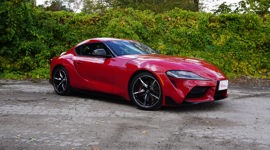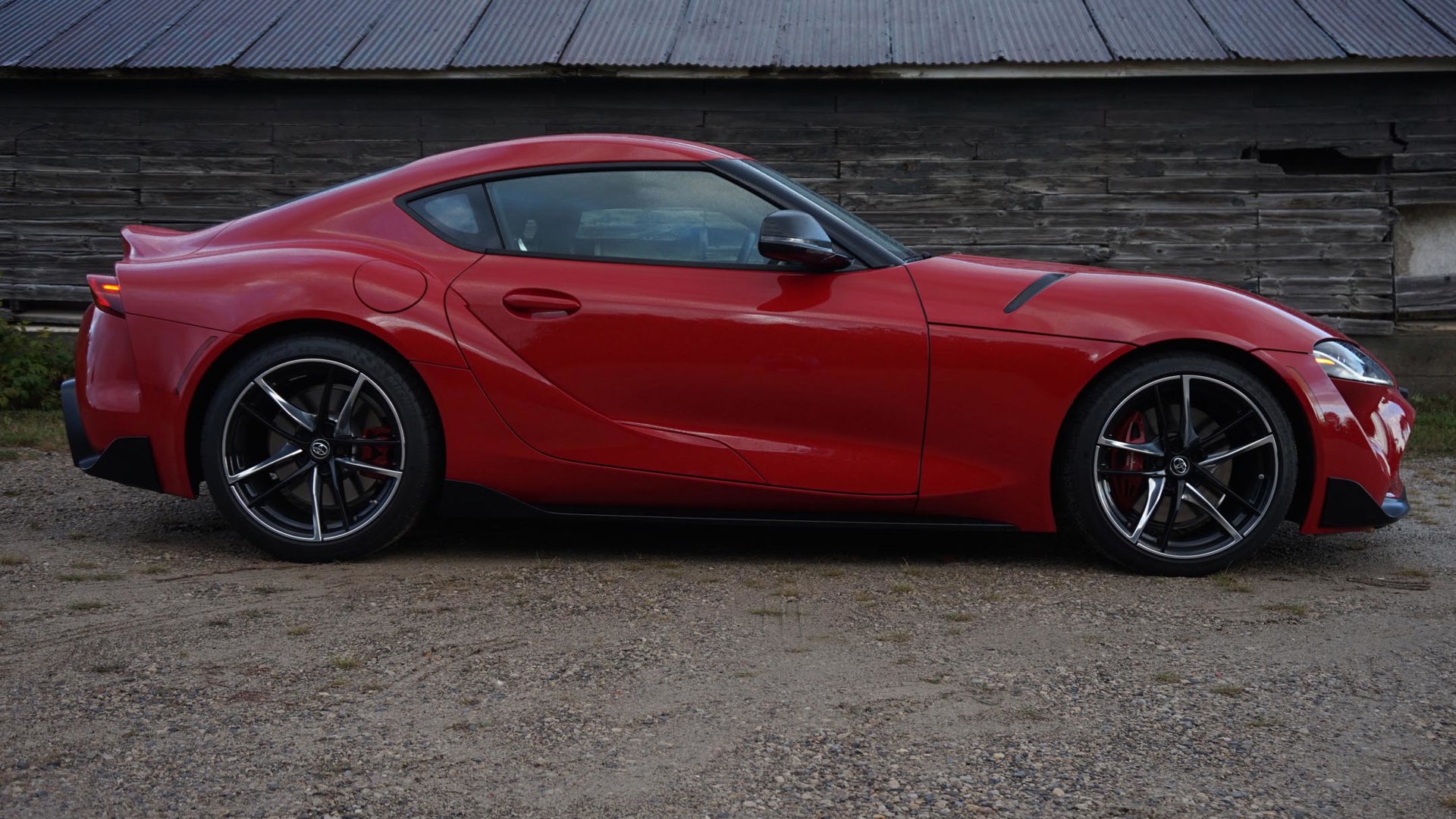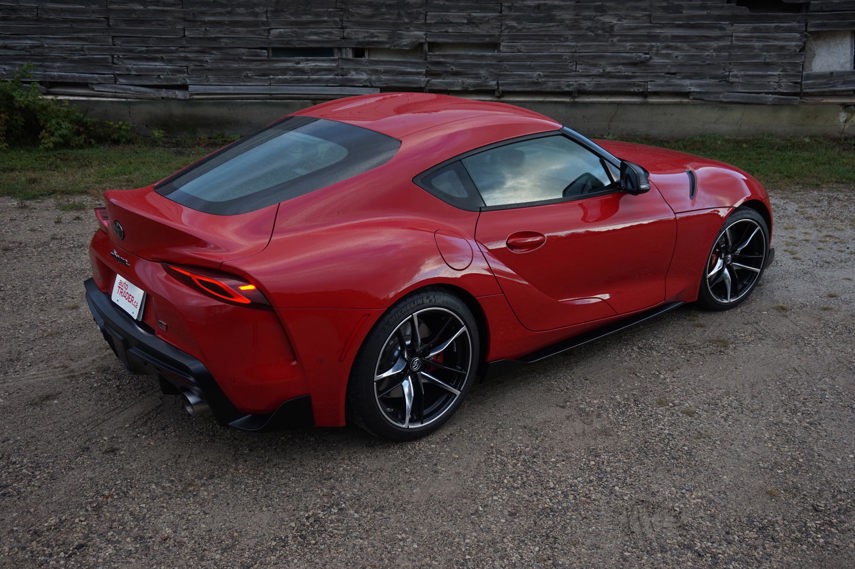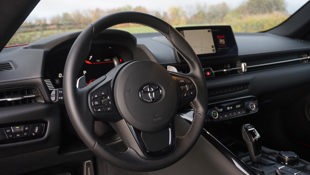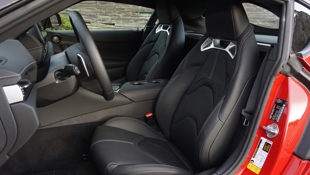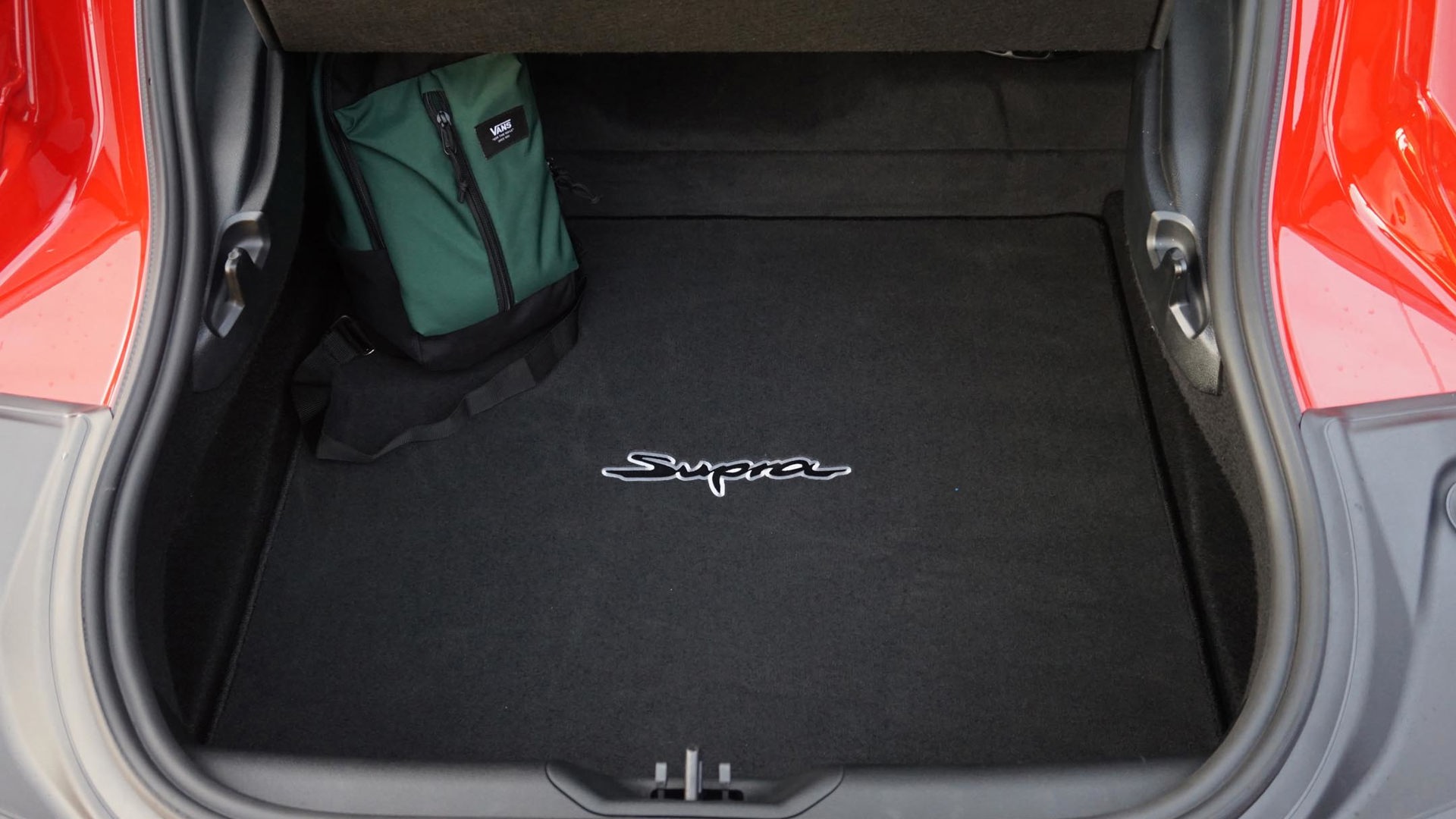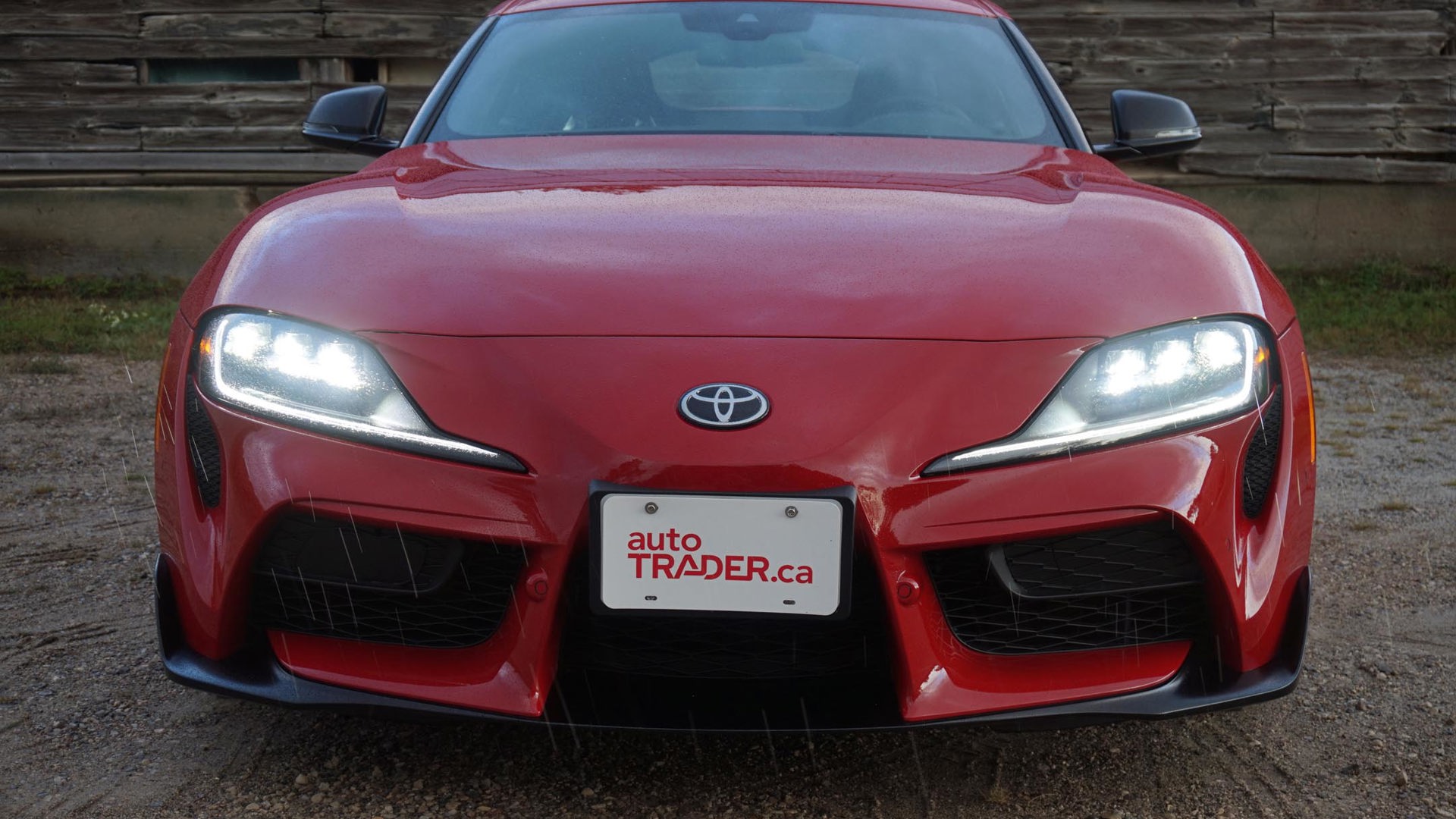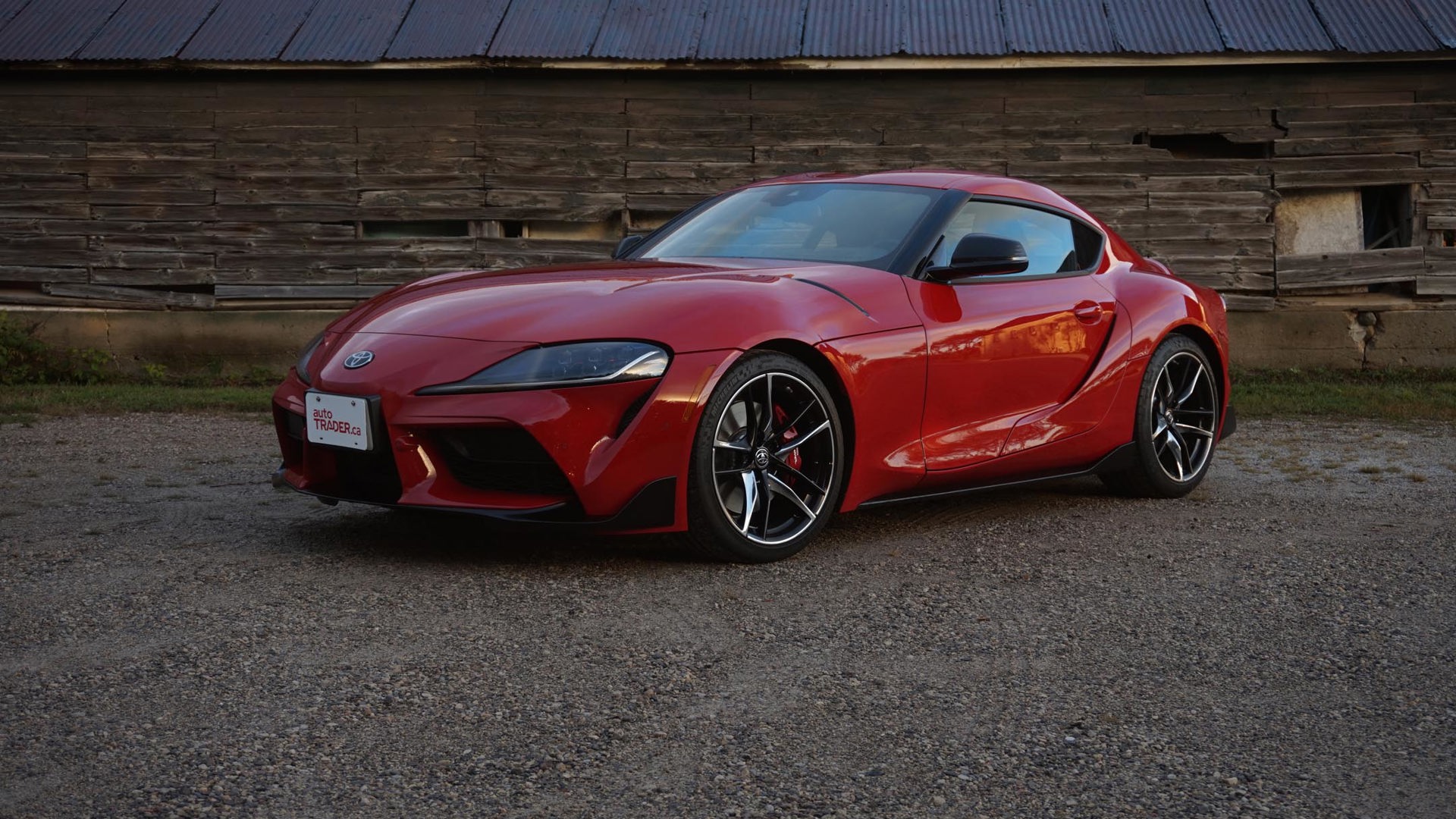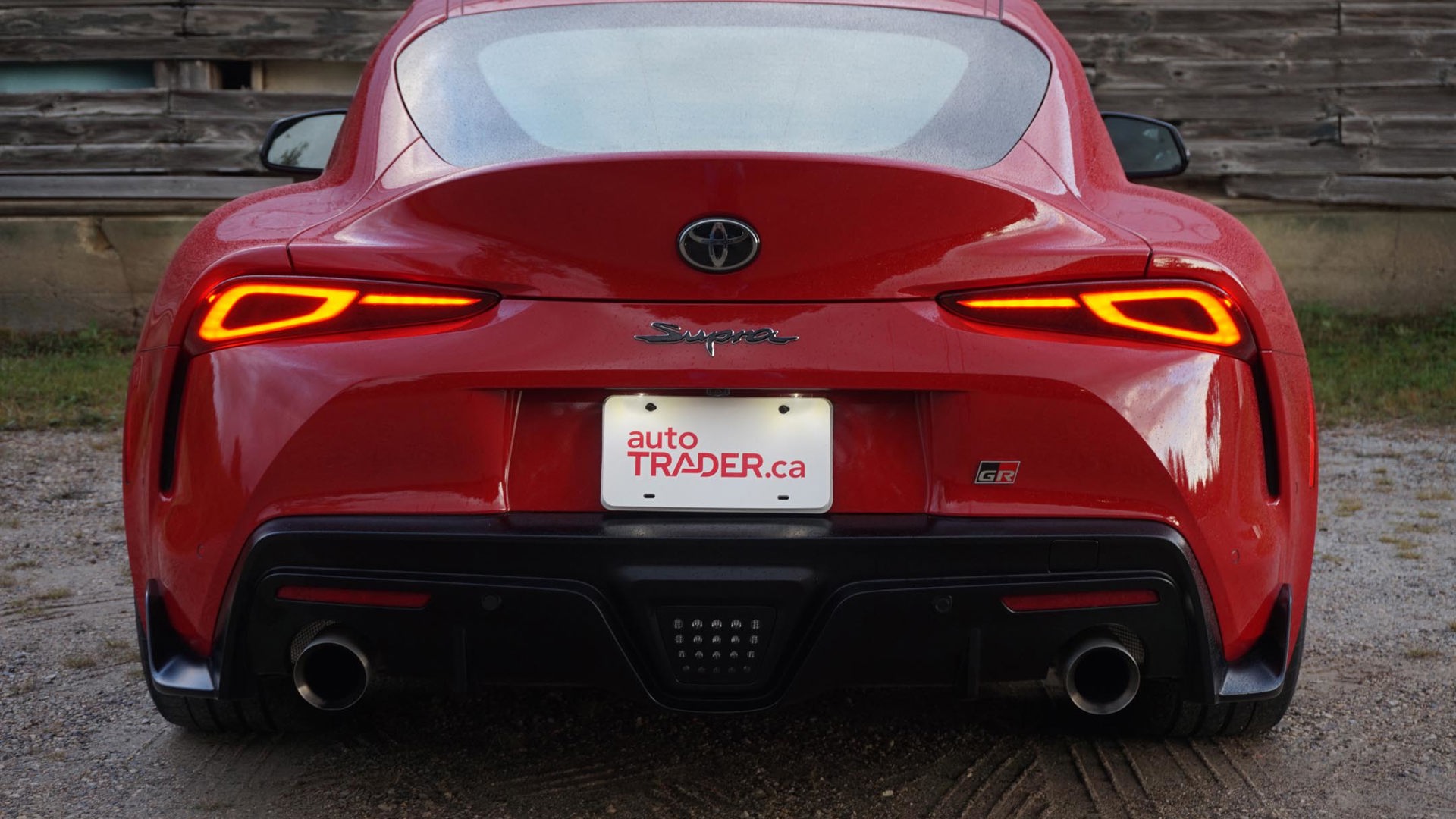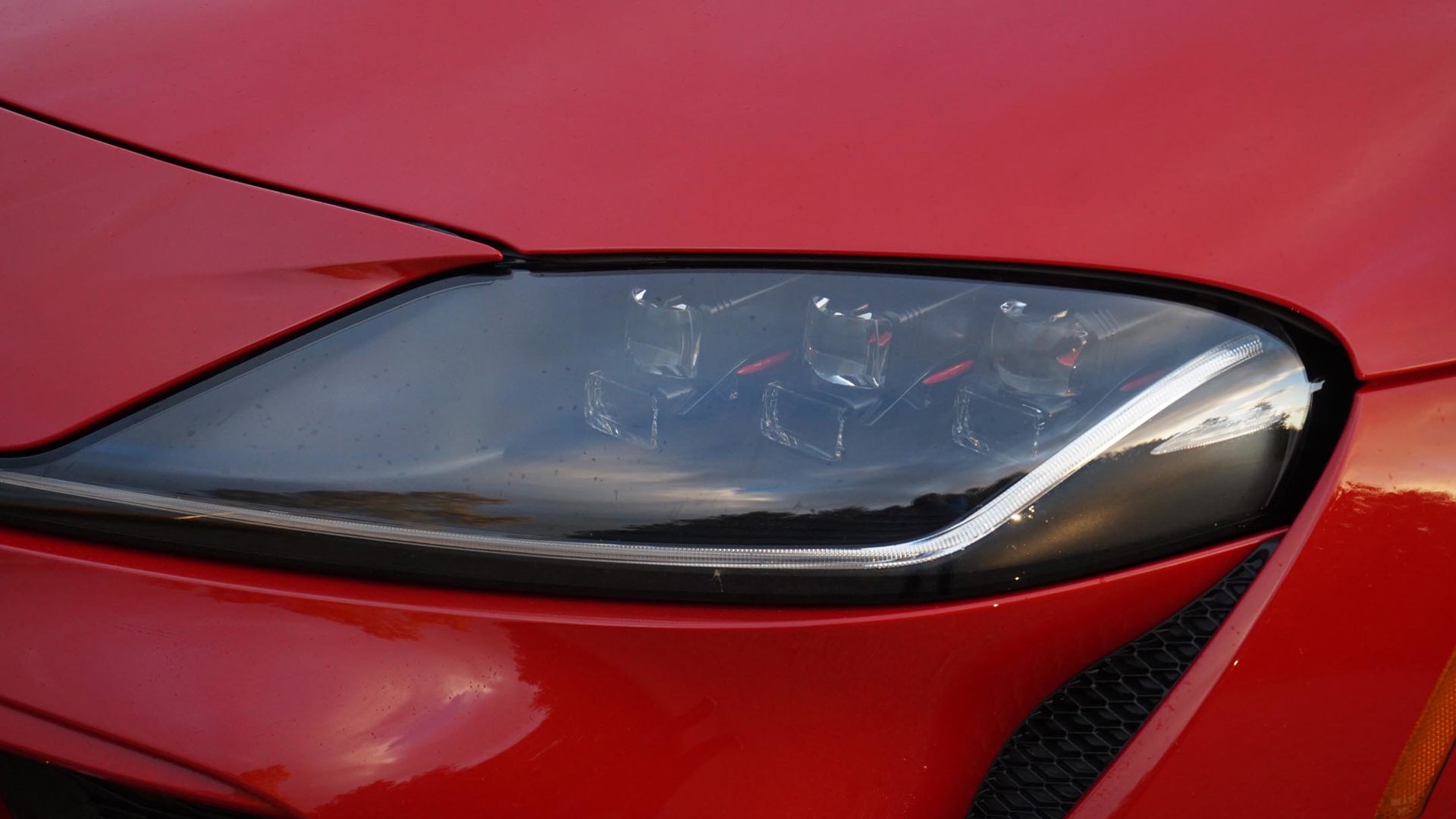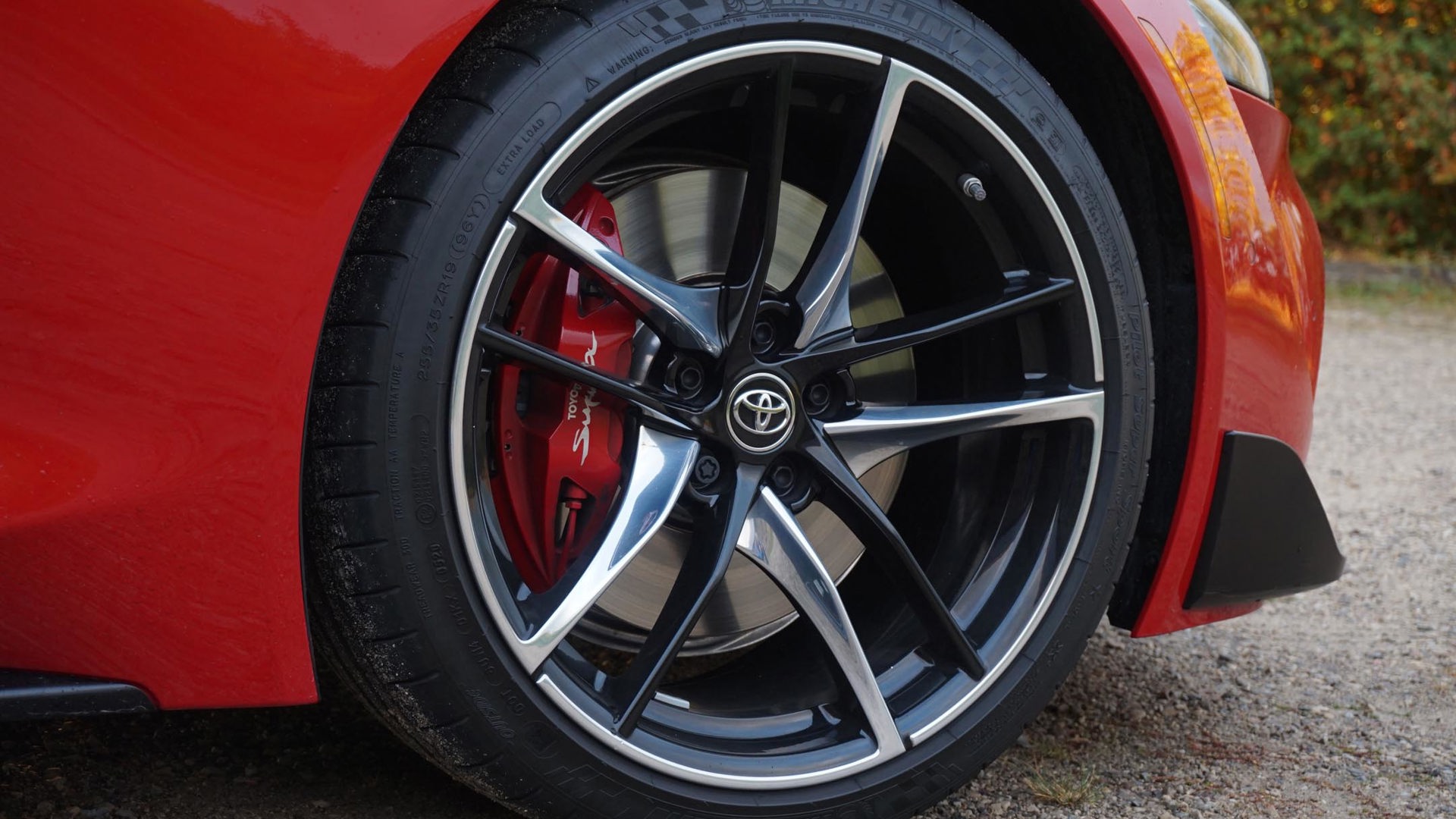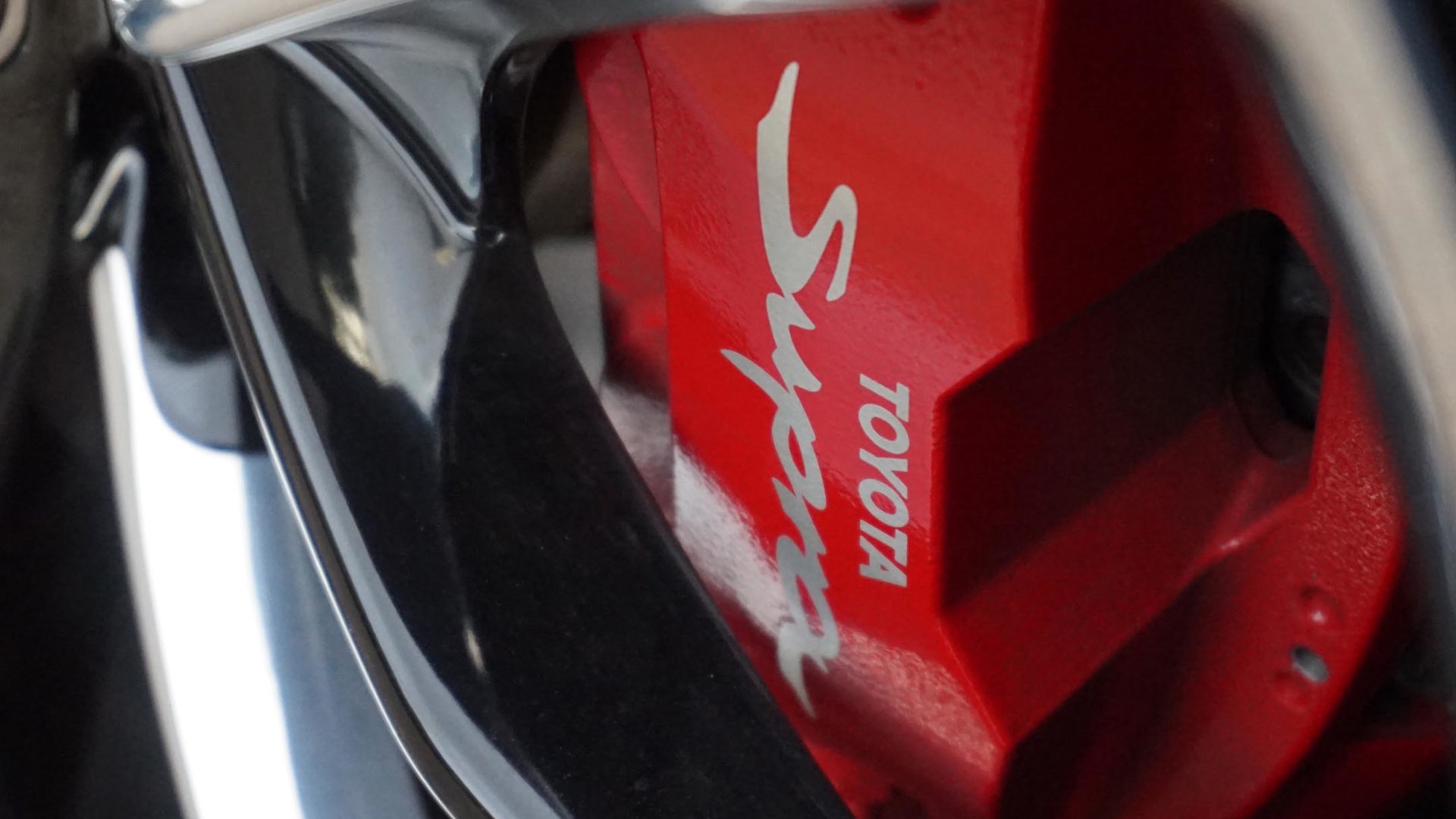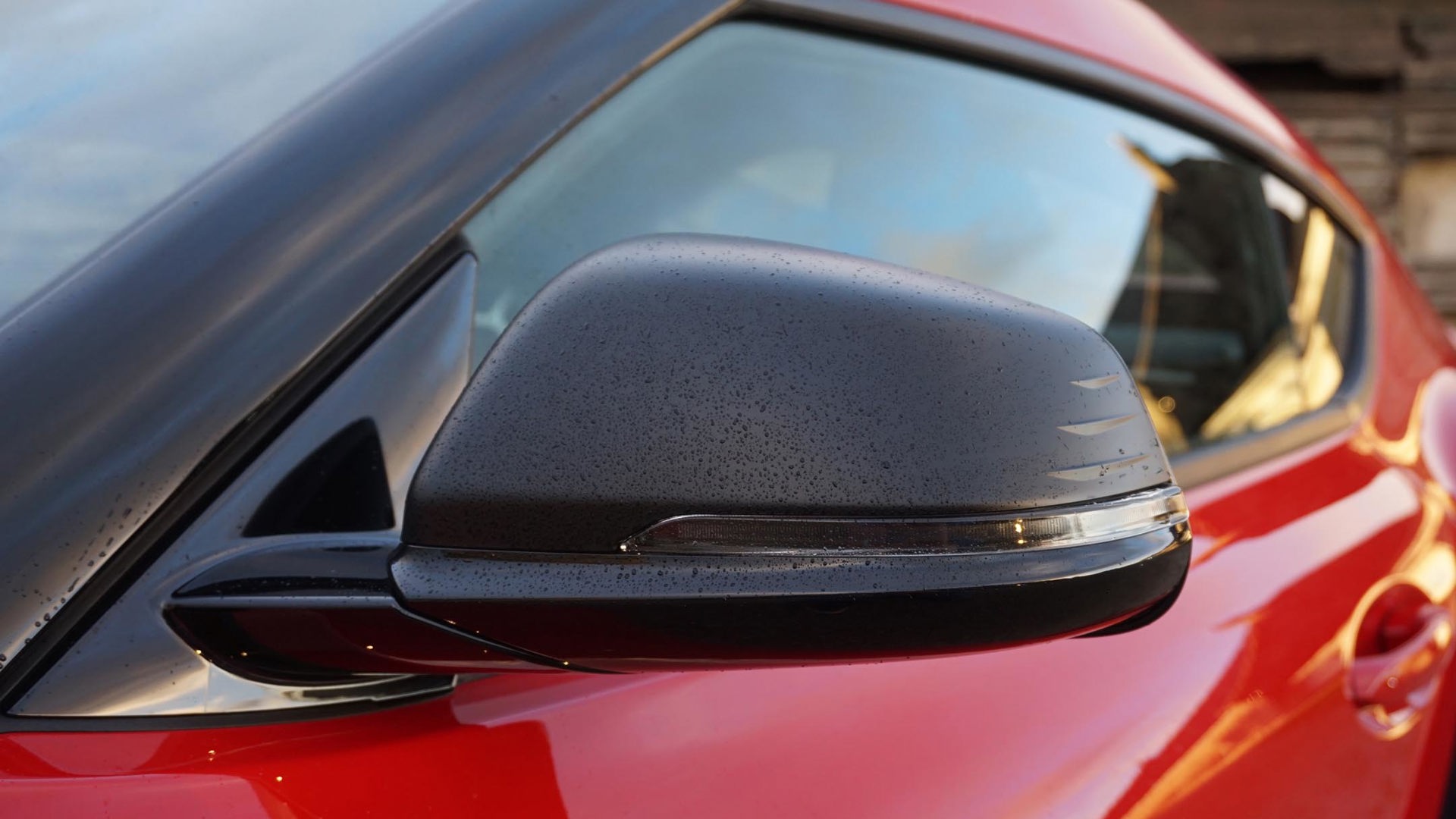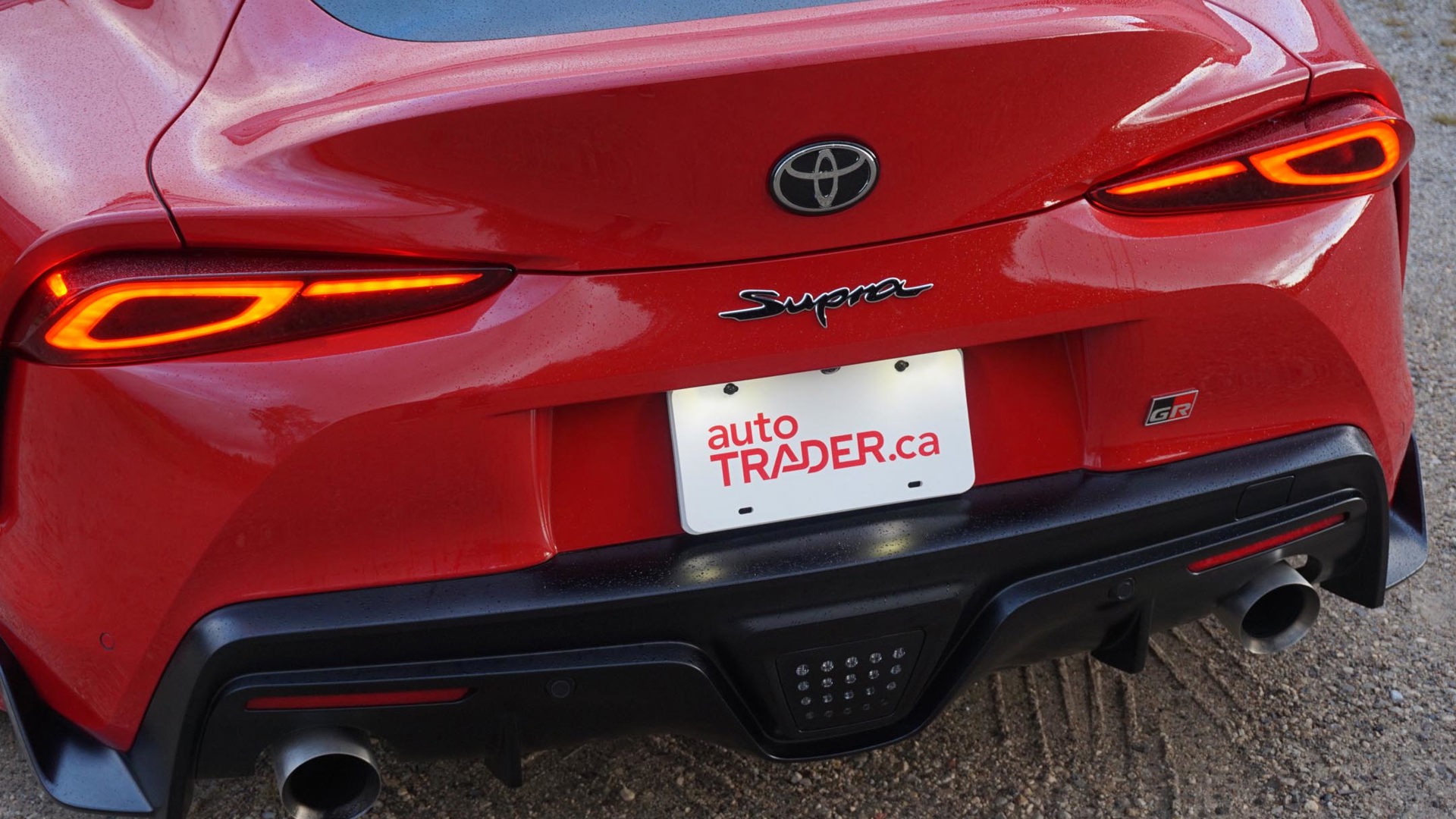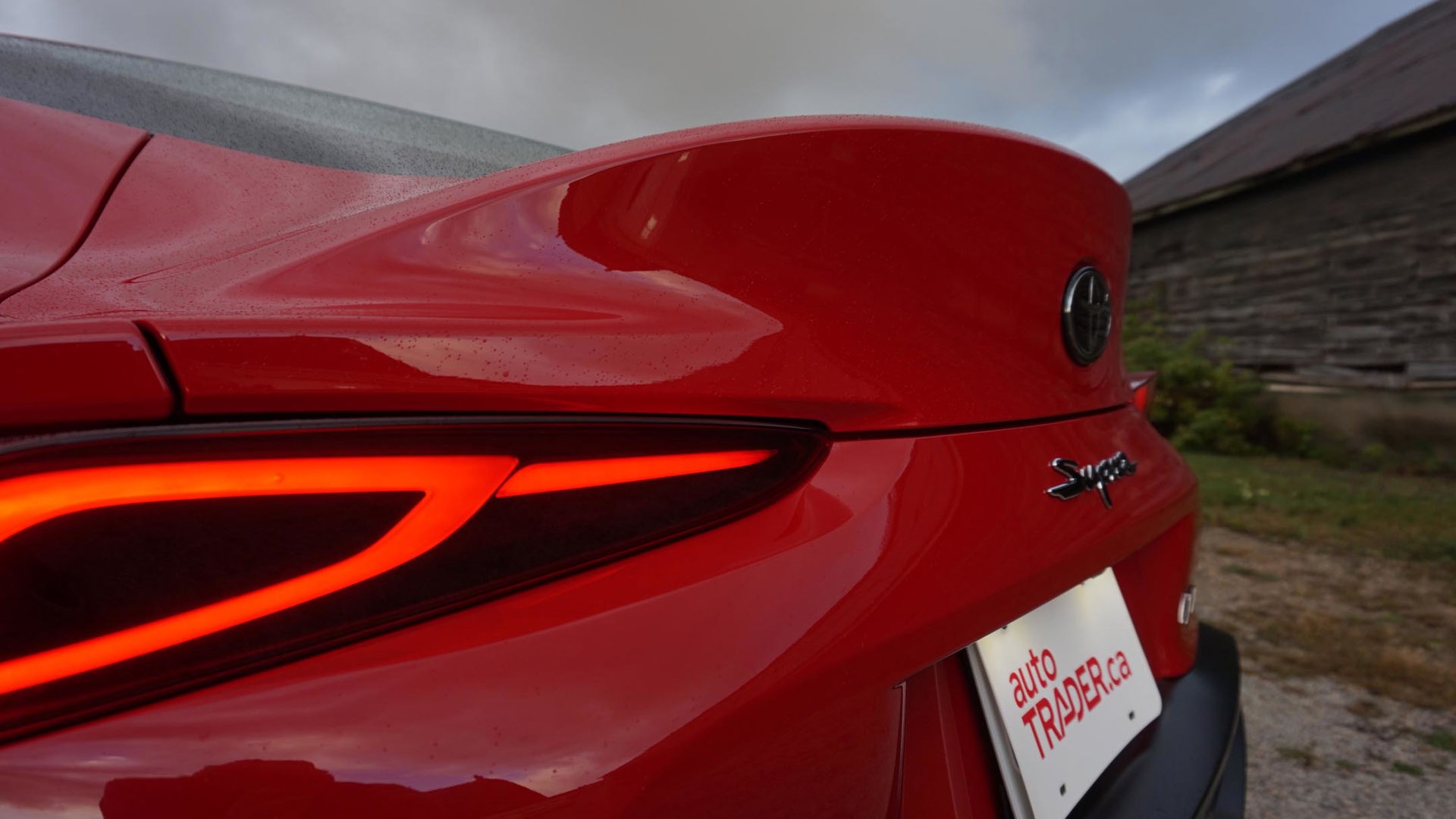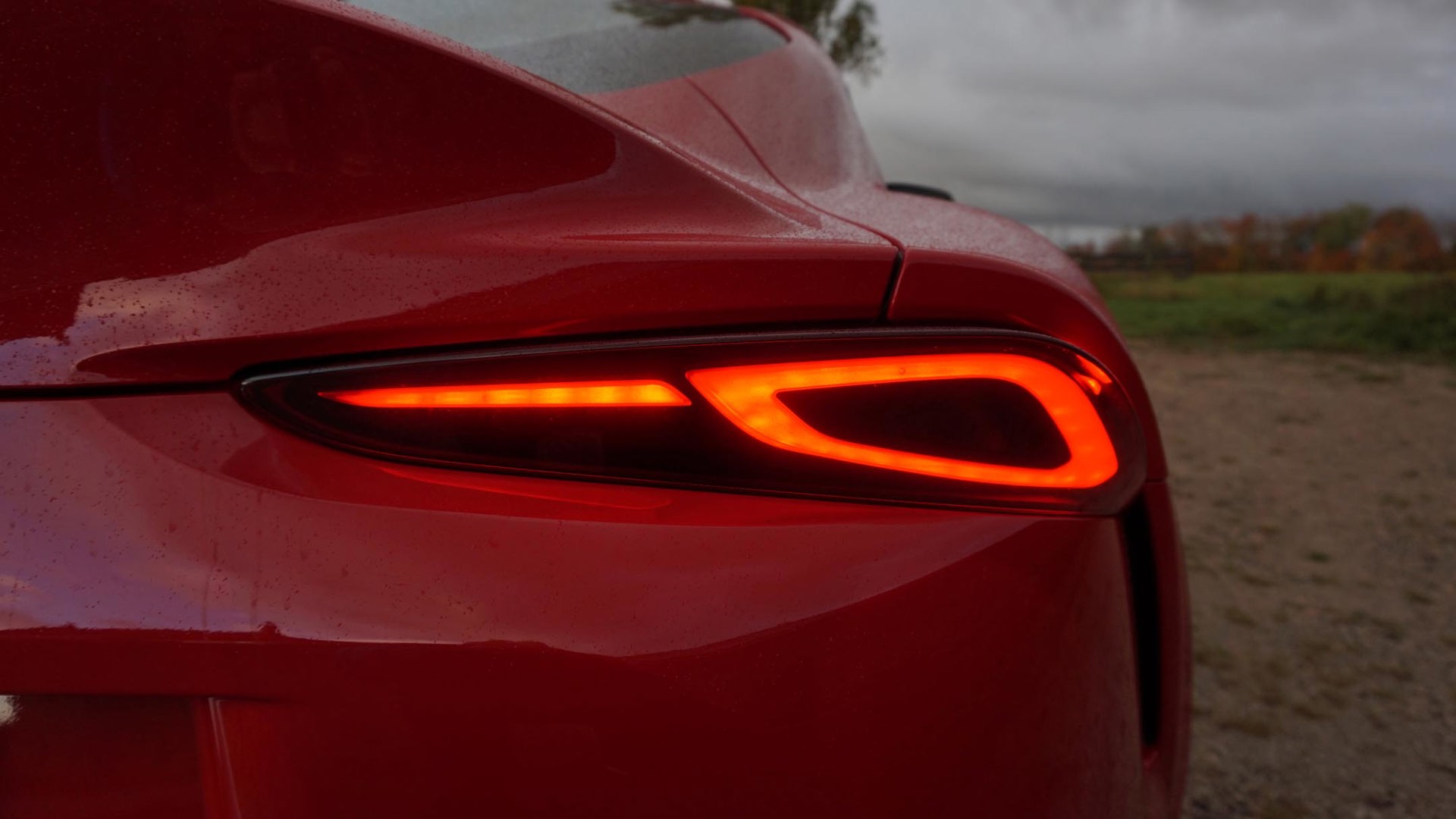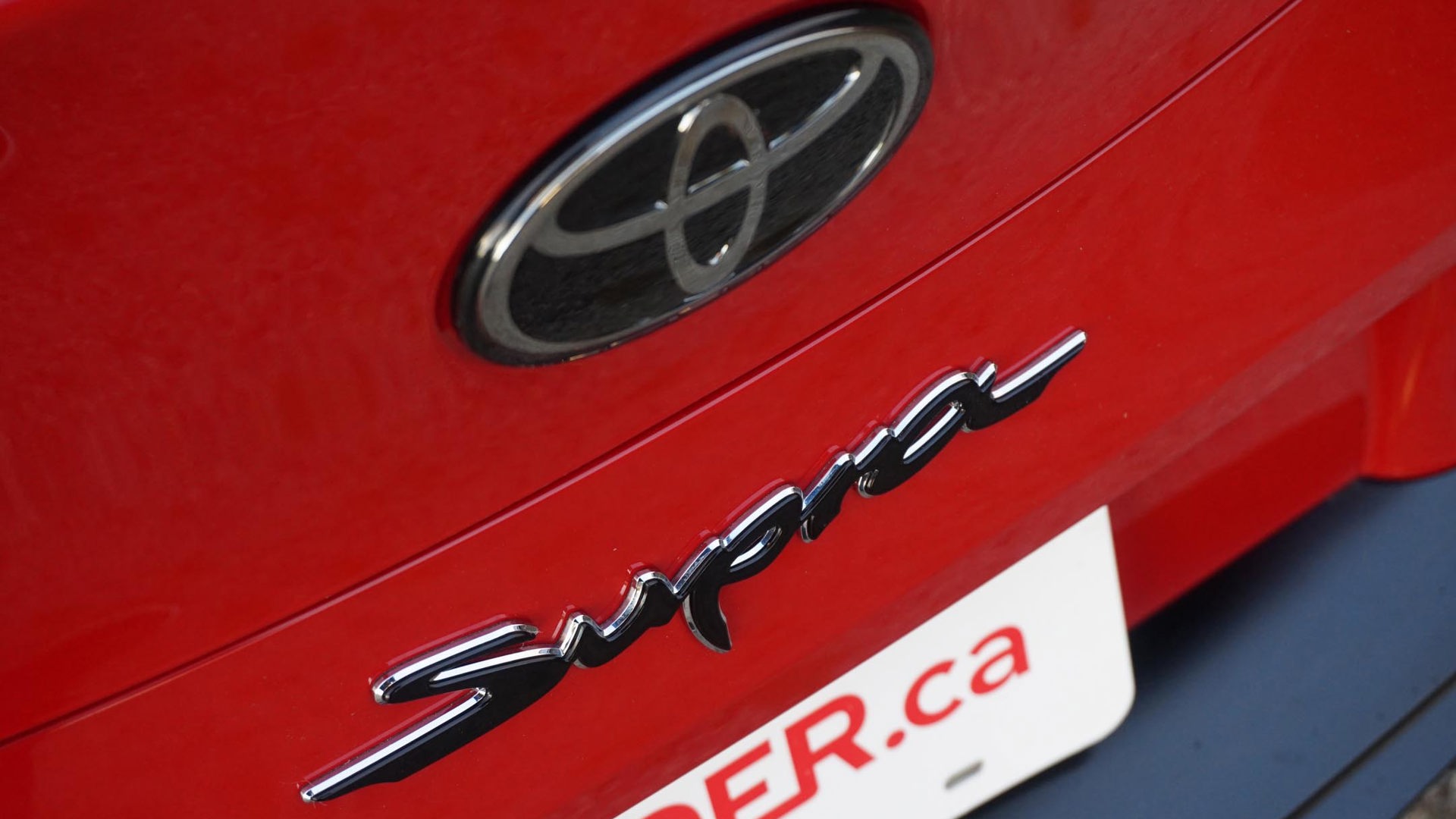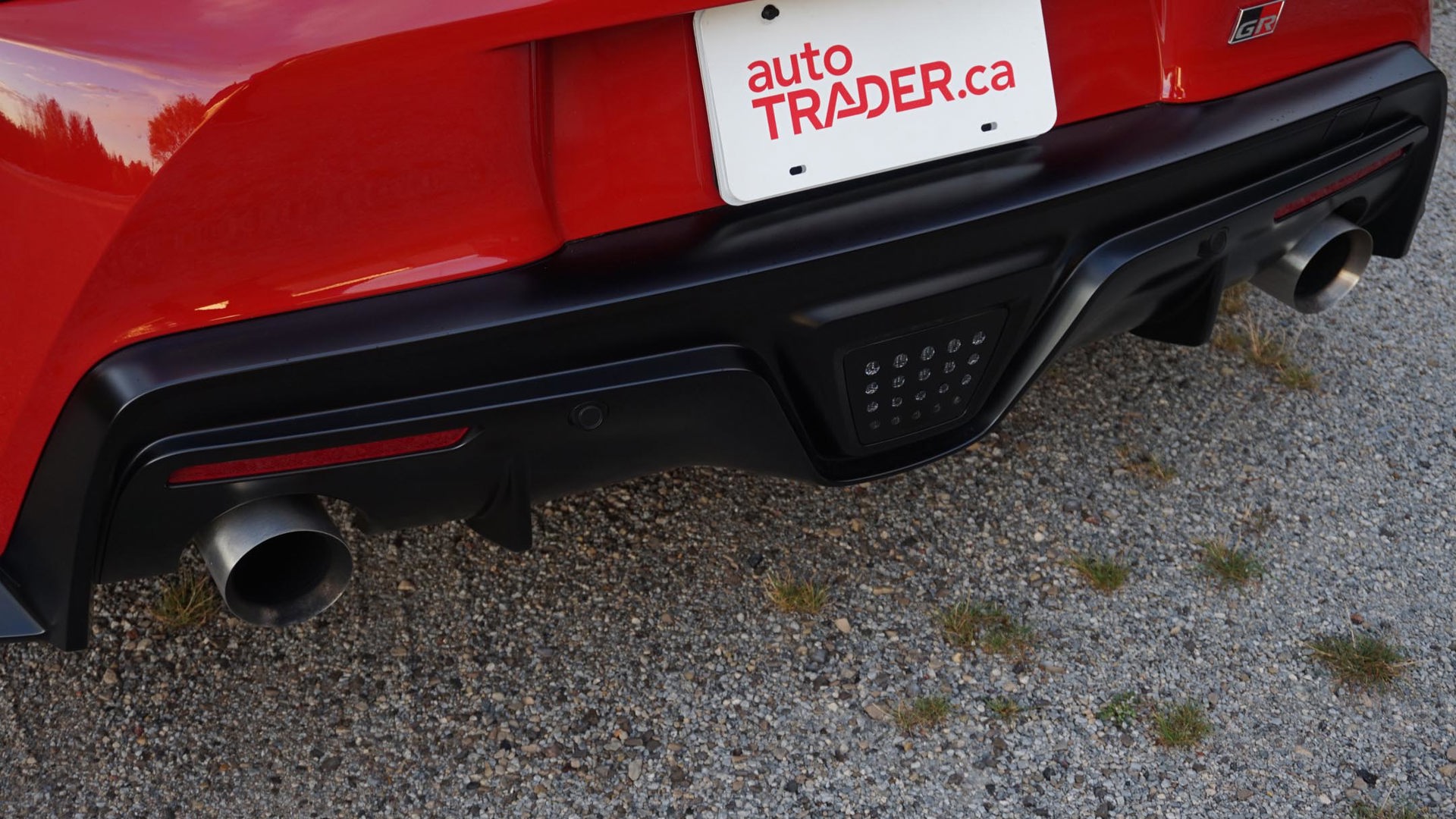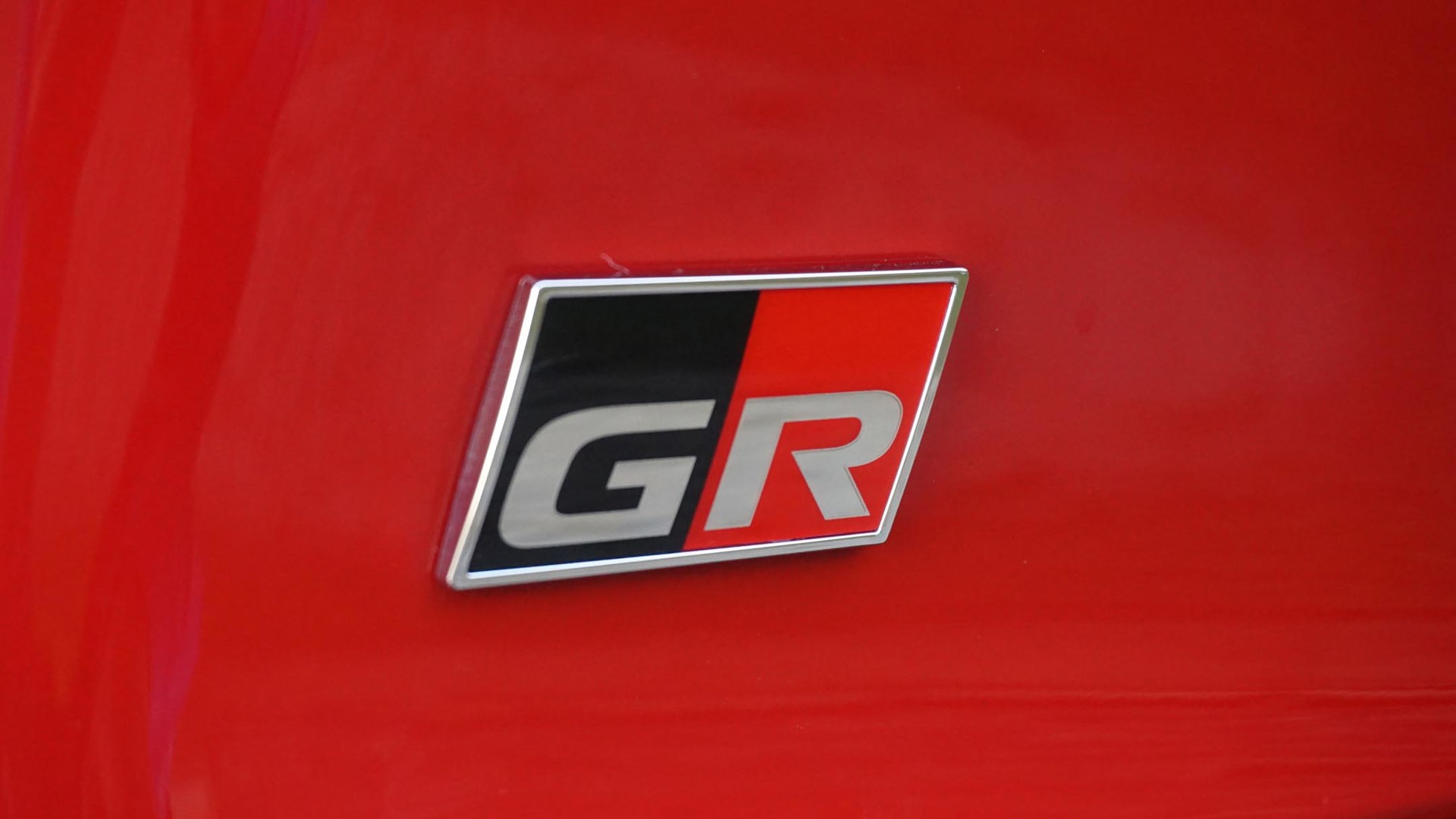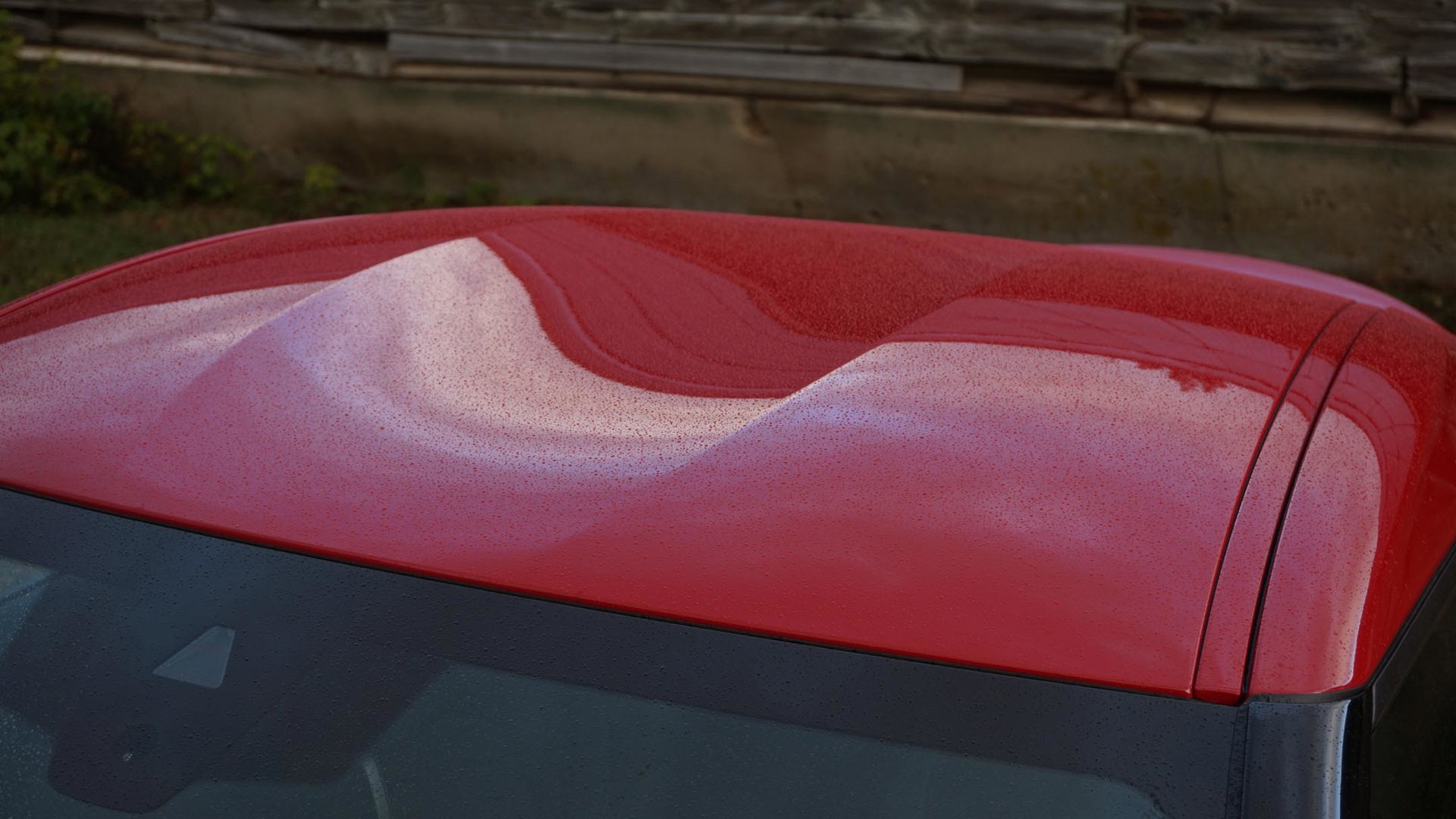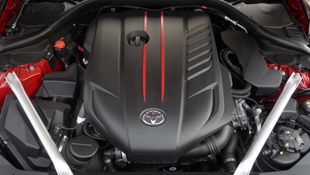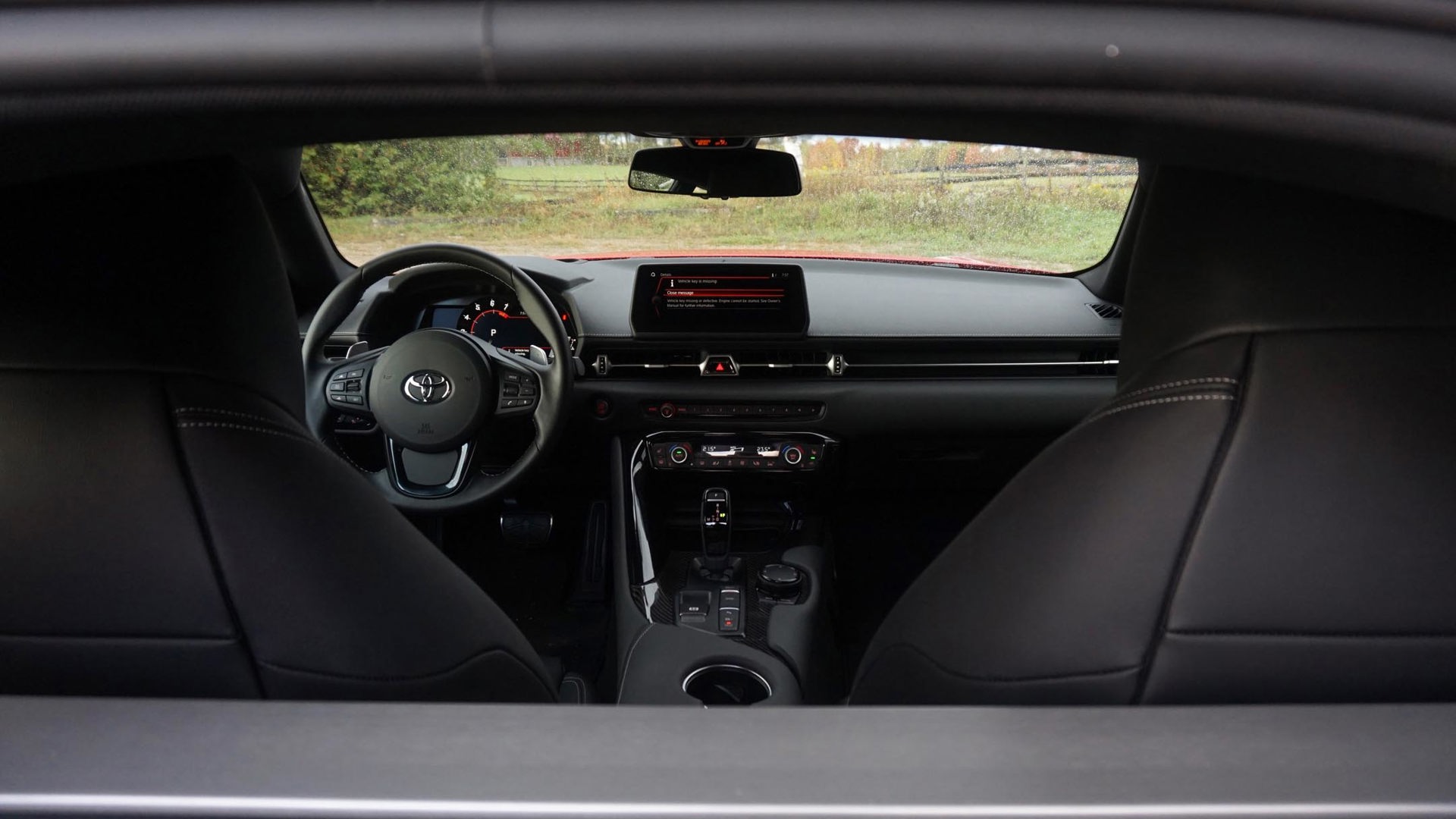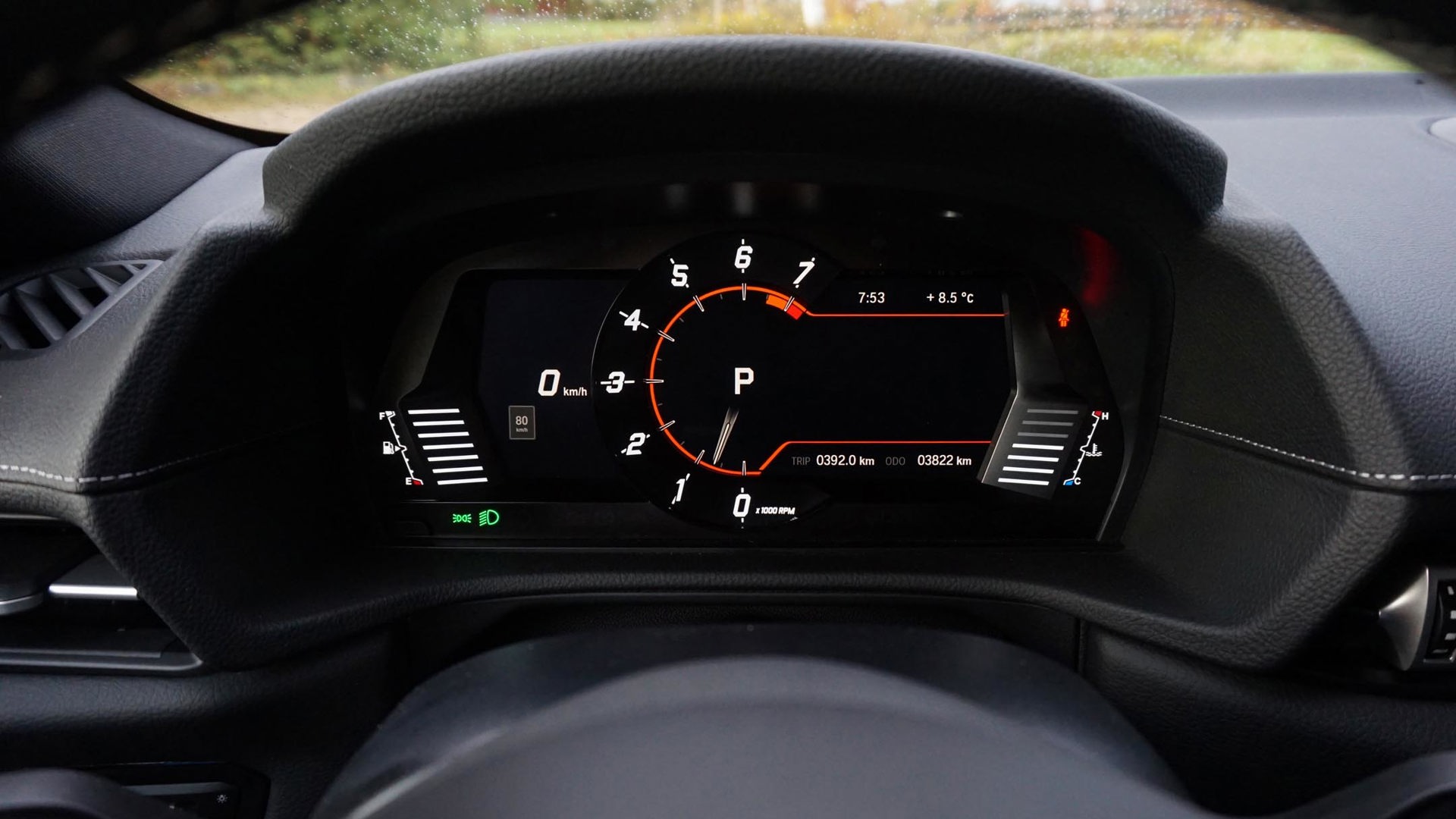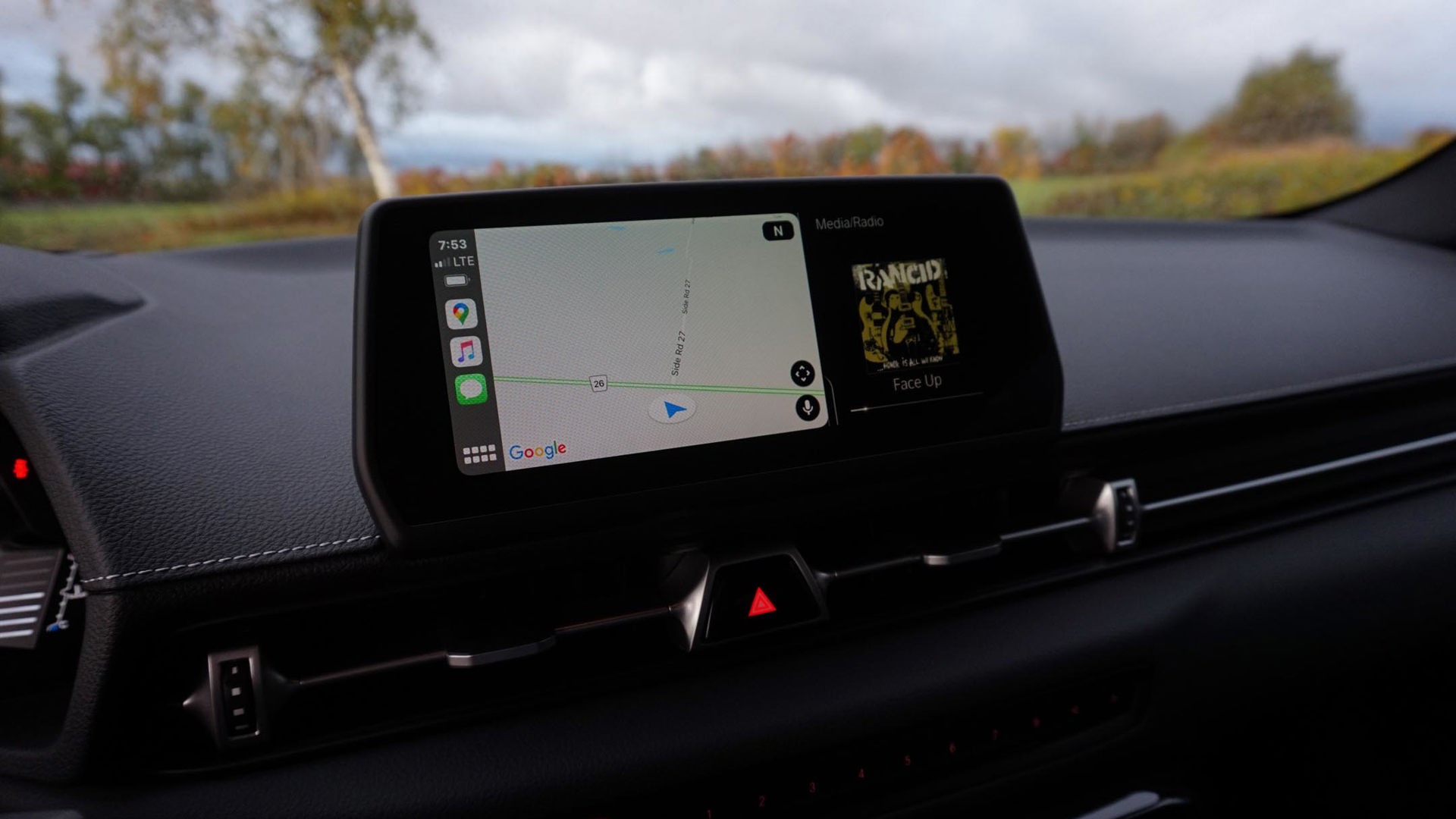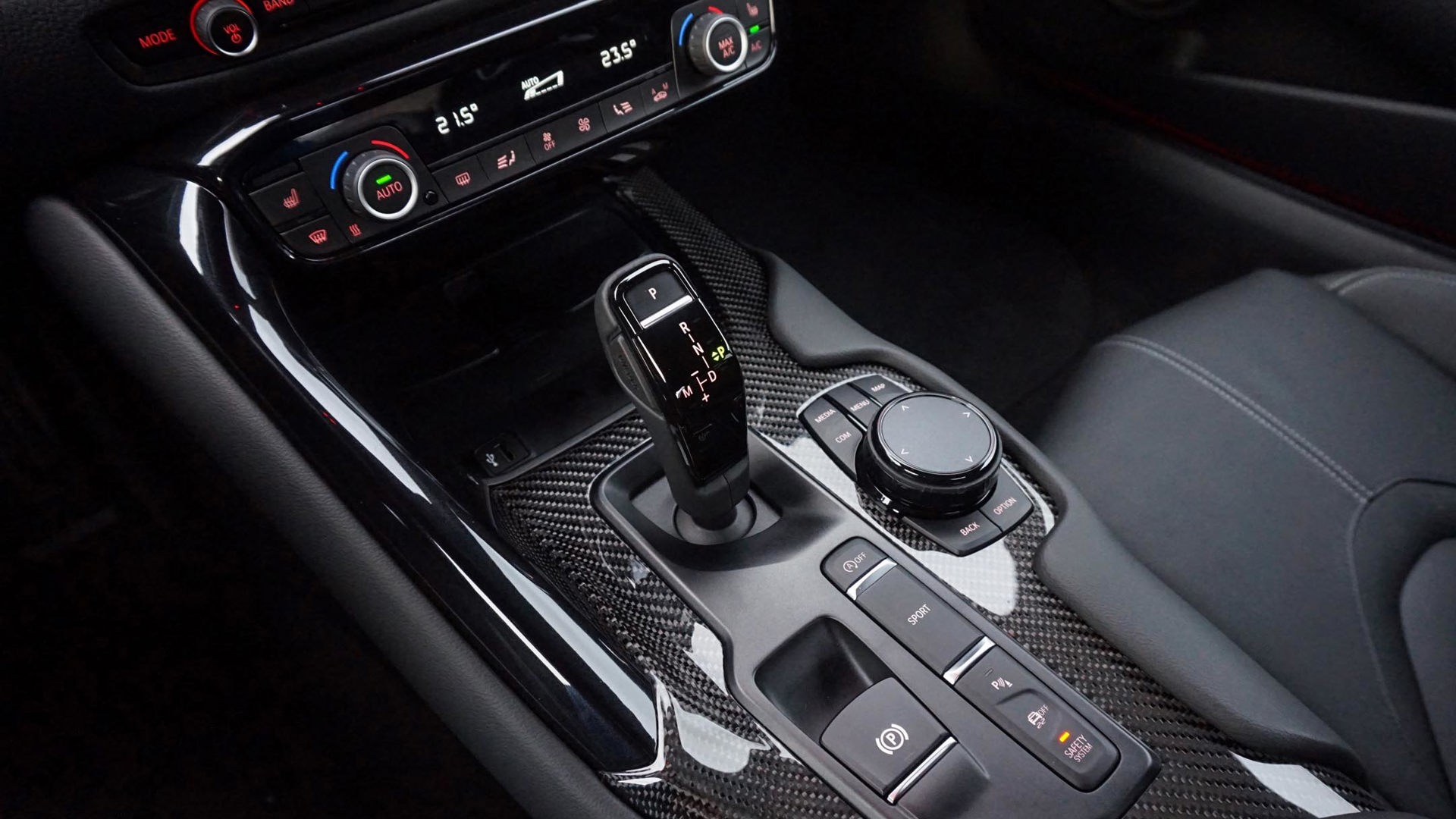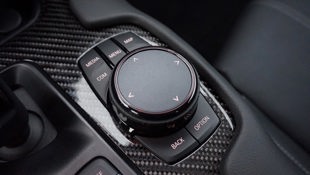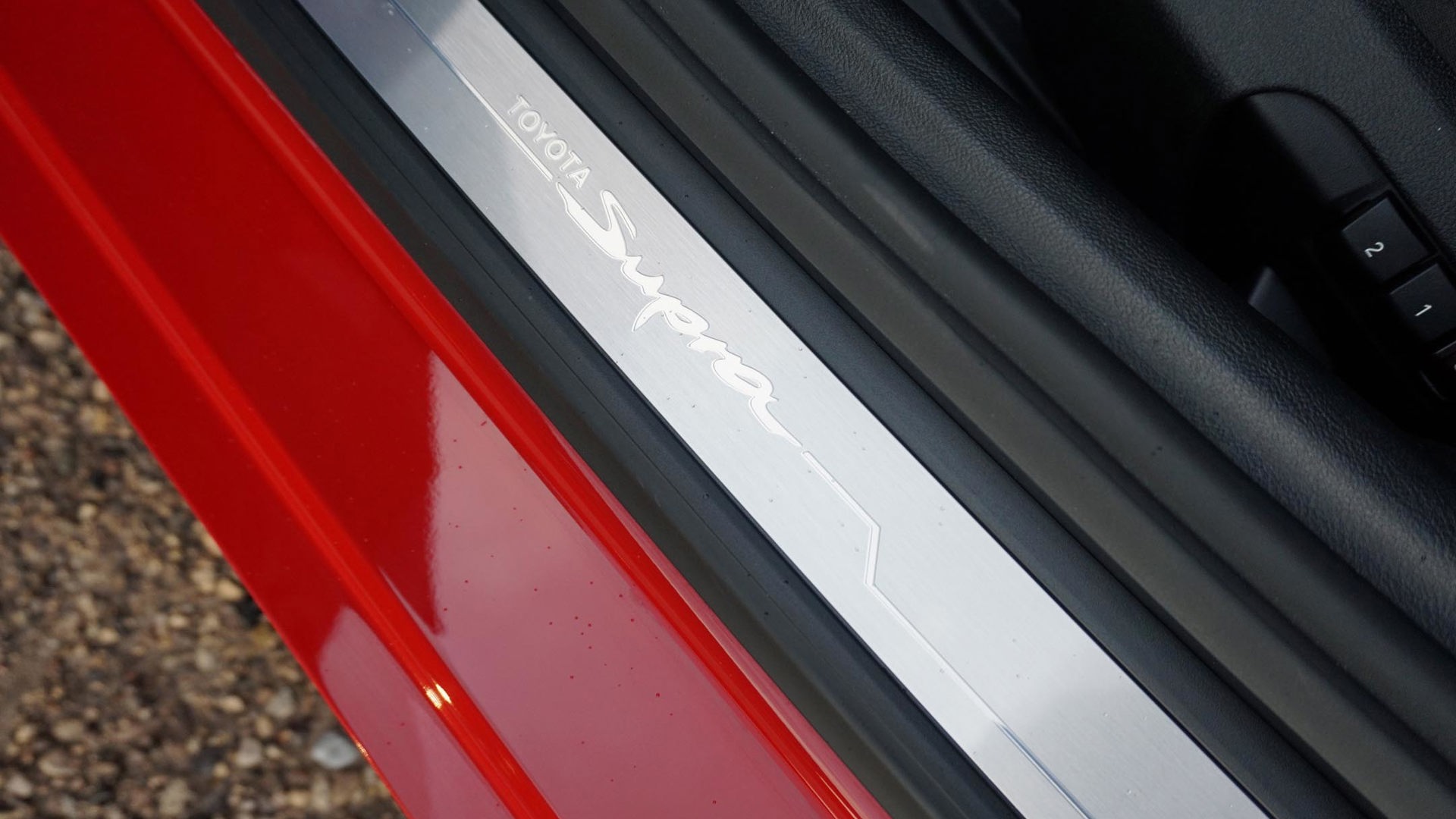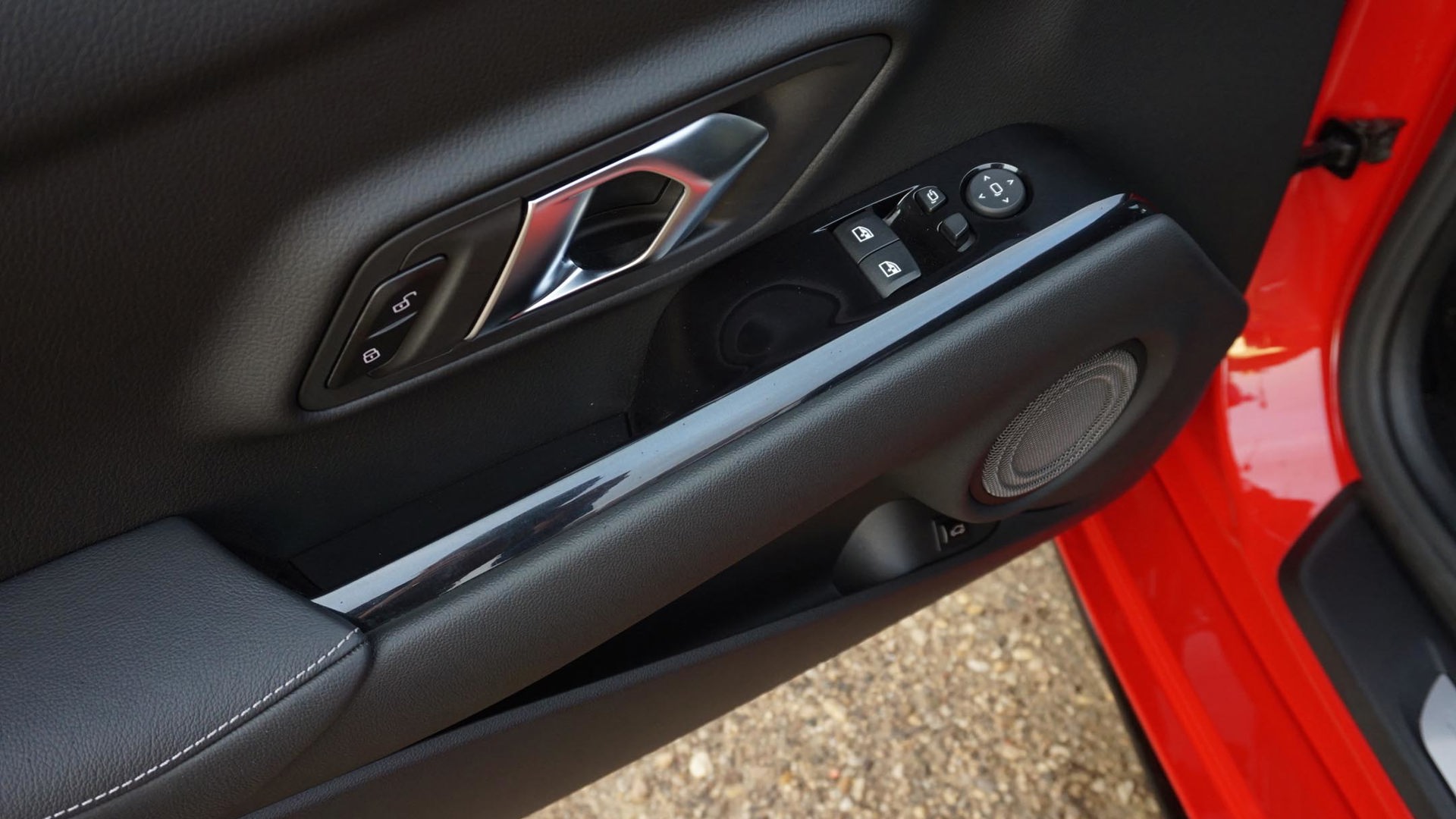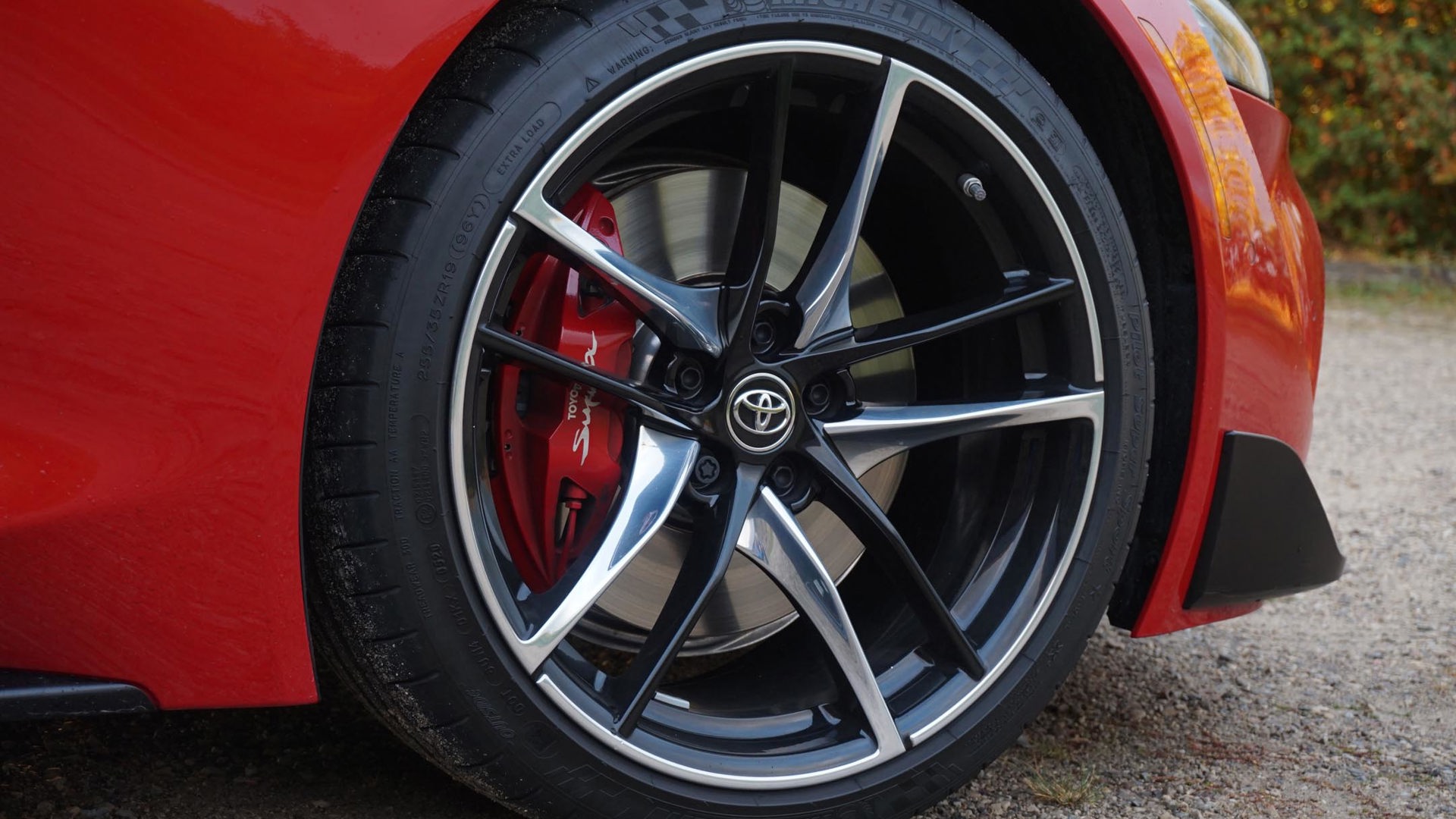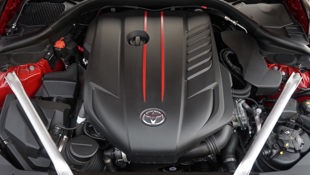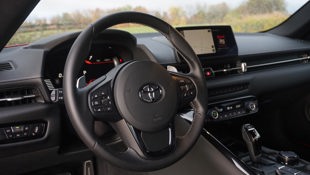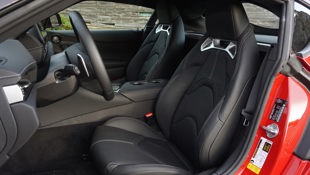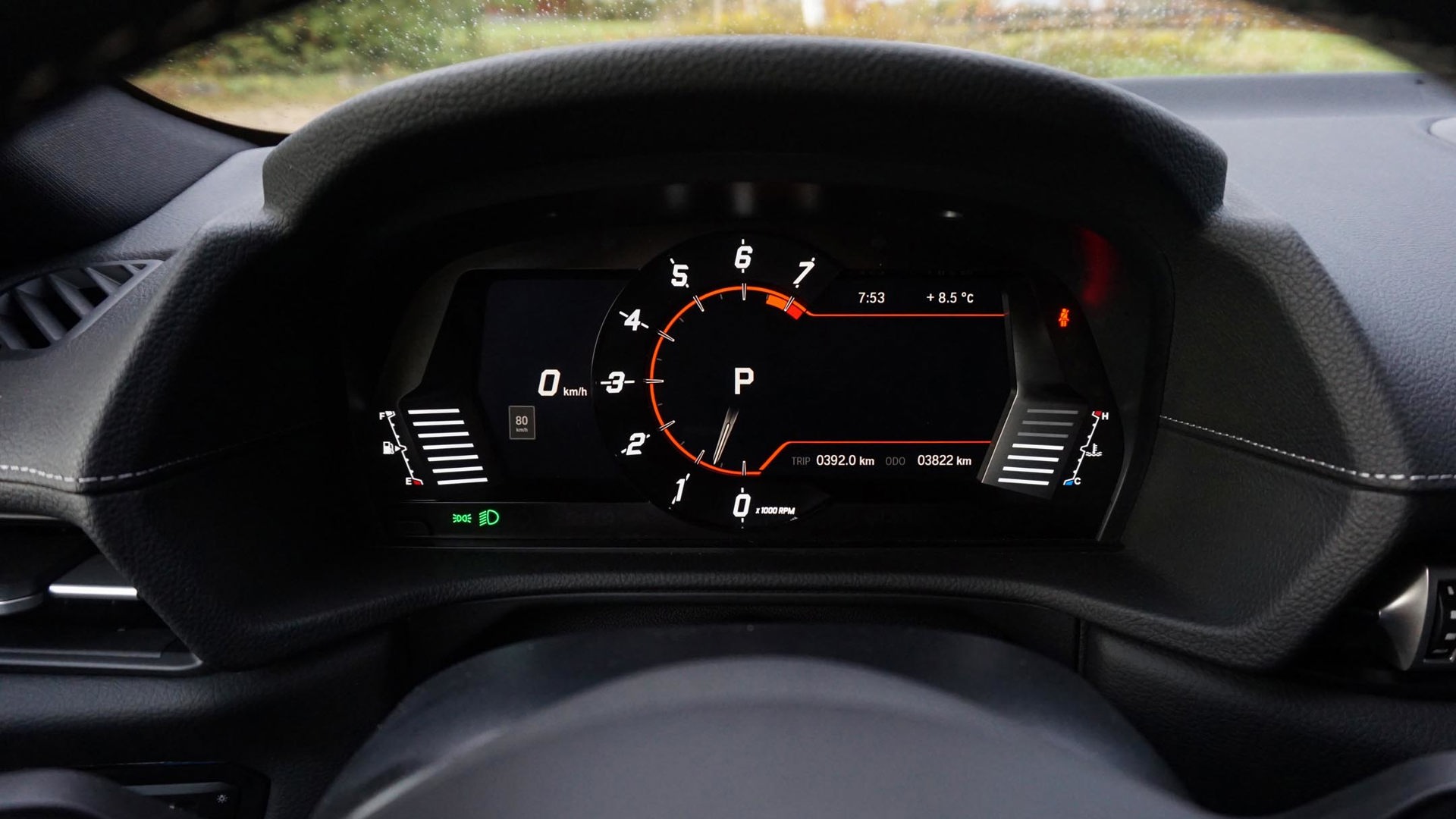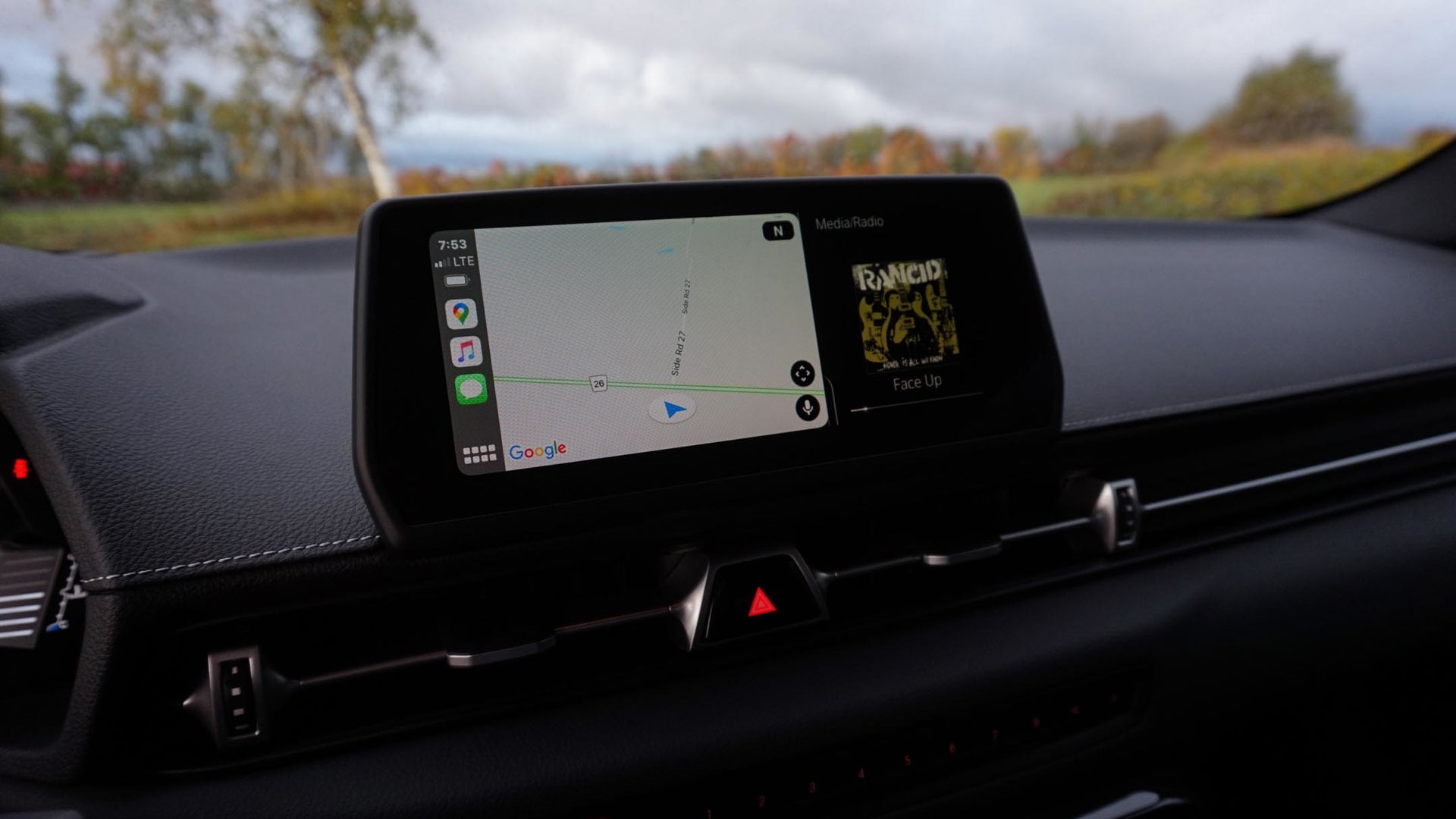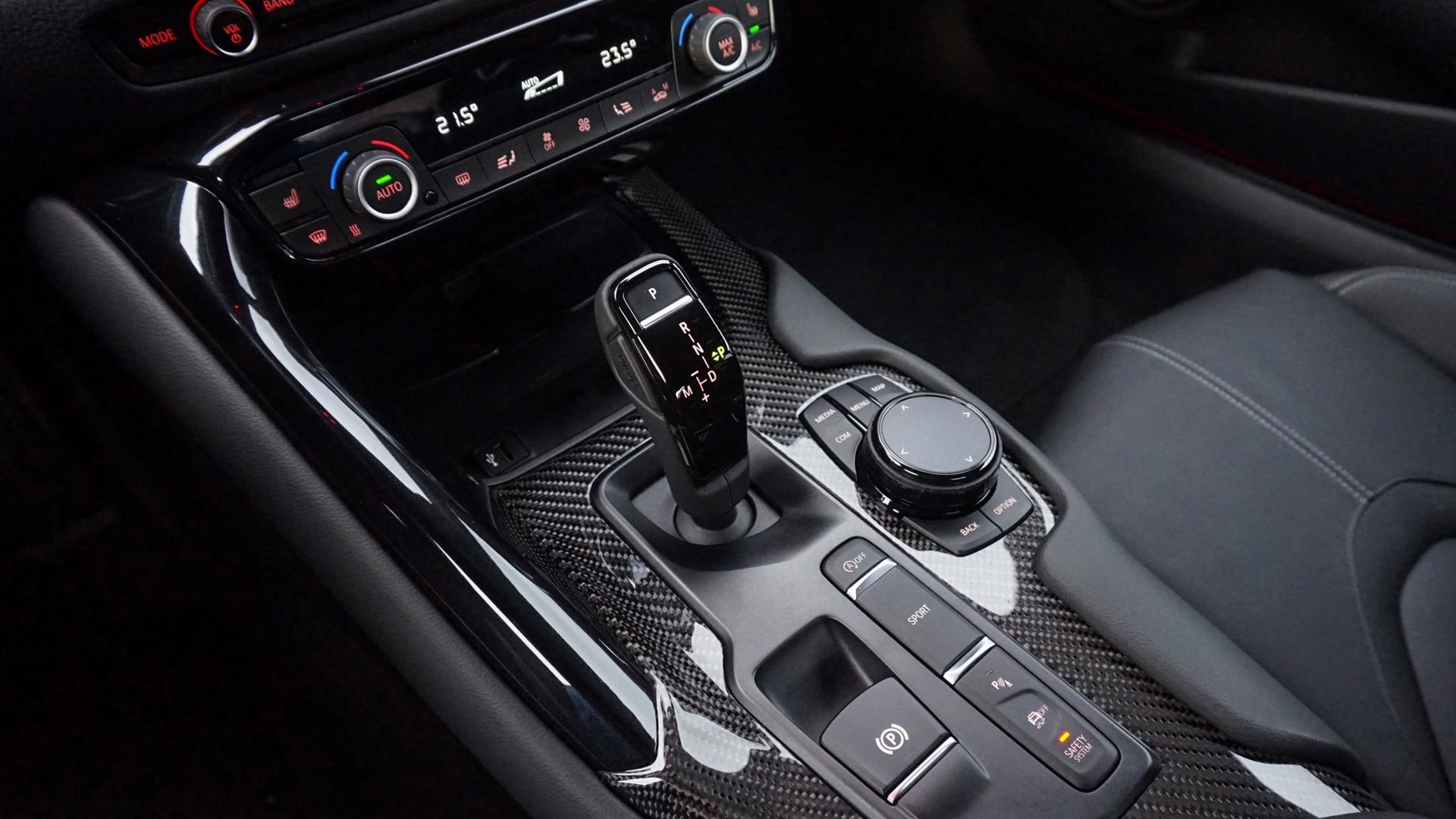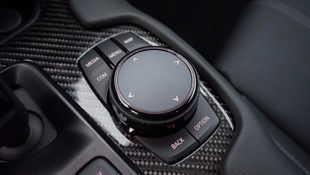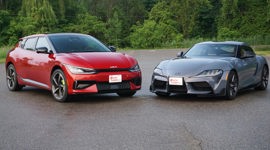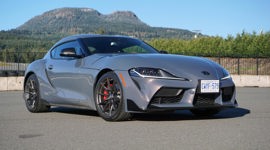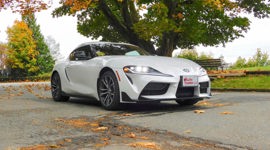 AutoTrader SCORE
AutoTrader SCORE
-
STYLING10/10
-
Safety9/10
-
PRACTICALITY7/10
-
USER-FRIENDLINESS7/10
-
FEATURES8/10
-
POWER10/10
-
COMFORT9/10
-
DRIVING FEEL10/10
-
FUEL ECONOMY9/10
-
VALUE8/10
There’s certainly an argument to be made that the 2021 Toyota Supra would be better with three pedals and a manual transmission.
After all, rowing your own gears – in a sports car, no less – has long been crucial to the essence of the drive experience. It’s what connects us to our cars in the most fundamental of ways and provides a holistic sense of control from behind the wheel.
But to get caught up criticizing the reborn Supra for what it doesn’t have is to overlook all the reasons that make driving it so intoxicating. Like the way the car reacts to gear changes at anything close to the top of the rev range, surging ahead with a neck-snapping momentum that simply wasn’t there a split second before. Or how its hips swivel and squirm under bursts of acceleration in a fun and familiar way that’s reminiscent of the playful Toyota 86, only with almost as much torque as a Porsche 911 Carrera S.
Whatever your expectations are of this car, know this: they’re probably wrong. Unless, of course, your preconceptions involve declaring the modern interpretation of Toyota’s transcendent sports car successful in its mission of delivering performance that punches above its weight at a price that’s well below it. In which case, welcome aboard.
Power: 10/10
After a year on the market, the Supra lineup on these shores has expanded to include the base turbo motor previously sold exclusively in parts of Europe and Asia. That BMW-sourced four-cylinder makes 255 hp and 295 lb-ft of torque – numbers that don’t exactly incite enthusiasm. Granted, I’ve not yet tested the 2.0L-powered car, and it would be unfair to declare it dead on arrival. Instead I’m going to, um, strongly suggest it’s worth springing for the big engine.
After all, there’s something sacred about a Supra with a straight six-cylinder under the hood. Is it because that’s the way it’s been since the car’s humble beginnings in the late 1970s? No doubt. But it’s also because the configuration remains among the most balanced, harmonious, and smooth to ever grace an engine bay. No, it’s not the hilariously tunable 2JZ of old, but this BMW-built 3.0L certainly is in keeping with tradition.
To create some separation from the four-cylinder car, the straight-six received a bump in output for its sophomore year, with 382 hp and 368 lb-ft of torque on tap. Power in particular sees a healthy increase over last year’s car, which made 335 ponies, and puts the Supra on equal ground to the BMW Z4 with which it shares its mechanical underpinnings.
With a single turbocharger forcing more high-pressure air into the combustion chambers, there’s barely a hint of anything resembling lag as the Supra claws ahead with the quickness of a six-figure performance car, its eight-speed automatic snapping off shifts faster than what seems fair to just about any other automatic out there. Routing all that torque to the rear wheels via a limited-slip differential – a feature not found on the base car – results in a controllable sway to the Supra’s hips under heavy acceleration, the engine’s combustible force fighting hard against the traction provided by the sticky 275-mm section width tires tucked under the rear fenders.
Driving Feel: 10/10
That transmission remains a serious point of contention amongst car enthusiasts, and they’re not necessarily wrong. Because if ever there was a candidate for a manual gearbox it would be the reincarnation of a car like the Supra. That it’s offered only with an automatic seems to run counter to the very spirit of the sports car. Yet the notion that this machine is in any way a disappointment because of the method it uses to channel engine output to the pavement below misses the point entirely.
The Toyota 86 – as well as its mechanical twin, the Subaru BRZ – is an old-school sports car that leans heavily on its manual transmission to make the drive experience engaging. In the Supra, the gearbox’s job is a simple one: turn combustible force into forward momentum, and do it quickly. Fun though a manual may be, it would take away from the Supra’s raison d’être of delivering performance that’s up there with much more expensive cars. (Besides, developing a transmission that only a small percentage of buyers would opt for anyway isn’t worth the time, effort, or investment required.)
In the Supra, the totality of the drive is absolutely mesmerizing, and the powertrain plays an important role, yes, but not the only one. The steering is chatty despite running through an electronic translator first, feeling crisp and precise. While obviously a by-wire system, it’s direct enough to do what it’s told with good response and feedback.
The suspension, too, is charming despite being misunderstood at first blush by your humble author, whose expectations got in the way of reality. Not that the adaptive dampers that come fitted to the 3.0L model are in any way uncomfortable; quite the opposite, in fact. And while they, like the motor, come from the BMW parts bin, the prediction was for a ride quality like the M2 Competition‘s, when what was delivered is, in fact, closer to 8 Series coupe‘s. It was initially difficult to come to terms with the softer-than-expected suspension system – that is, until I grew to adore it.
Make no mistake, the dampers are firm, particularly when toggled to their sport setting. Yet even then there’s a suppleness that, when fully appreciated, only adds to the Supra’s performance prowess. With just enough softness to play with, it’s easy to dive deep into the brakes and pivot the car on its front wheels before stomping on the gas and shifting its weight rearward to rocket out of a turn.
Comfort: 9/10
With the adaptive dampers set to normal mode – my preferred setting during a week-long test – the Supra is a proper grand tourer capable of gobbling up hours of cruising unperturbed. Only severely broken pavement was enough for the occasional rattle to make its way inside, and even then it never overwhelmed the suspension to the point of discomfort. The leather-lined sport seats, meanwhile, proved to be the perfect pairing, with 14-way power adjustment (including expandable bolsters) for both occupants that promise the perfect position is barely a few button-presses away.
Practicality: 7/10
Well, perfect for all but those standing 6-foot-3 or taller, it would seem. While it’s fair to expect cozy confines in a sports car such as this, the new Supra is reminiscent of my hardtop-equipped 1995 Mazda Miata for the way in which I have to slouch once sitting inside. Sadly, there’s no way someone of my stature would be able to wear a helmet inside, effectively rendering it useless on the race track.
User Friendliness: 7/10
The Supra also suffers from poor outward visibility through the rear and side windows, the sloping roofline reducing what can be seen from the driver’s seat. That the double-domed roof extends so high above the door glass means tall occupants must contend with a headliner that drops directly into view when looking out the driver’s window, forcing yours truly to crouch awkwardly. And then there’s the task of climbing into and out of the low-slung car to begin with, the top of the door frame continually victimizing my head during testing.
If there was one way the car’s cramped cabin pays dividends it would be the way in which the controls land well within reach of either seat. The console is kept relatively simple, with a smattering of buttons, an infotainment controller, and, of course, the gear selector, while the space on the dash above that houses a bank of climate controls and a row of radio presets. (Here’s the only place I’ll join the too-much-BMW chorus, because the cabin controls lean a little too heavily on the Bavarian brand.) Sitting just a few inches further up from there is the 8.8-inch touchscreen display that, despite its decent size, is dimly lit and runs a rather dated infotainment interface.
Features: 8/10
New for 2021, the system also features a wireless Apple CarPlay connection in the 3.0L-powered car, though it was finicky during testing, often refusing to reconnect after a brief stop. There’s also no wired CarPlay connection, nor is there Android Auto, but the top trim features built-in navigation and satellite radio, as well as a 12-speaker stereo that seems excessive in a car this small but sounds great nonetheless.
Also new this time around for the 3.0L model is a wireless phone charger, while it also gets a head-up display and those wonderful leather sport seats. Just like the faux-suede-covered ones in the base version, those chairs feature three-stage heat but no ventilation, while the steering wheel doesn’t come heated. Both features simply should be equipped in a car with this kind of asking price. (Since we’re on the subject of comfort features, while the climate control system is of the dual-zone automatic variety, it seems a strange oversight that there’s no button to sync the temperatures of both sides of the cabin.)
Both versions of the Supra come fitted with a computer-modulated launch control system, but the 3.0L model adds a fistful of other performance-related goodies. There’s that limited-slip differential, those adaptive dampers, and an active exhaust system – though it sounds awfully German when it burbles and spits. It also comes fitted with bigger Brembo brakes than the base car’s, hollow stabilizer bars front and rear, and some new strut bracing to crank up the rigidity. Toyota says the second-year Supra was also on the receiving end of some chassis and suspension tuning tweaks.
Safety: 9/10
As part of the brand’s mission to bring advanced safety to the masses, both Supra trims get stuff like blind-spot monitoring with rear cross-traffic alert, automatic high-beams, lane-departure warning with steering assist, forward automatic emergency braking with pedestrian detection, and a traffic sign recognition system. There’s also adaptive cruise control that works in stop-and-go traffic. Of course, none of it was used during testing, with Toyota providing a handy button on the console to shut the systems down for unencumbered driving.
Value: 8/10
Because ultimately that’s what a car like this is all about. Safety is a noble cause, and I’m certainly not here to discredit that in any way, but If I wanted to spend Supra money on one of Toyota’s mobile cocoons of crash prevention technology I’d buy something with a Lexus badge on the grille.
It’s also safe to assume I’d head straight for a Supra powered by a straight-six, with lots of extras for the roughly $11,000 premium over the base model. The $58,000 pre-tax price for the four-cylinder Supra manages to seem a little steep, though the slightly more than $69,000 a 3.0L will set you back before the government gets its share seems rather reasonable. Sure, there are other great performance cars on the market for that kind of cash – the new mid-engine Chevrolet Corvette springs to mind, not to mention the M2 Competition and the Porsche 718 Series – but the one-trim Toyota Supra 3.0L delivers an awful lot for its asking price.
Fuel Economy: 9/10
It’s also somewhat frugal for its performance acumen, with both its fuel consumption ratings and real-world results rather miserly. According to Natural Resources Canada (NRCan), this is a car that should burn 10.6 L/100 km around town, 8.0 on the highway, and 9.4 combined. Granted, that’s premium-grade gasoline, but those ratings are better than the Toyota 86/Subaru BRZ, as well as those aforementioned competitors. While my week-long test registered a slightly worse 11.0 L/100 km over the course of nearly 700 km, even that’s a respectable number given the manner in which the Supra was driven.
Styling: 10/10
No matter which way it was driven, the Toyota Supra easily ranks among the most attention-getting cars I’ve tested in recent memory. Its rarity undoubtedly plays a role, but the shapely design warrants just as much credit. This is a car that certainly isn’t without its detractors, though there seems to be just as many fans out there. I find myself somewhere in between, admiring certain aspects – the duckbill spoiler built into the hatch, for instance – while finding others off-putting. The cabin is far more understated, meanwhile, and aside from the carbon-fibre panel on the centre console there’s not much to marvel at.
The Verdict
Judging by the kind of criticism that’s been swirling on social media since the Supra was reintroduced, it’s unlikely this is the reincarnation many fans had in mind. Respectfully, I retort that it’s for the best none of those folks are in charge at Toyota, because this is a damn good sports car that’s worthy of both its price tag and the badge on the back.
The way it performs as both a purebred sports car and a grand tourer makes it supremely special, though it’s not likely the reborn Supra will ever get the credit it deserves; expectations have a funny way of obscuring our perception of reality like that. However, those with the clarity to see this car for everything it is certainly won’t be disappointed in the experience it delivers from behind the wheel.
| Engine Displacement | 3.0L |
|---|---|
| Engine Cylinders | Turbo I6 |
| Peak Horsepower | 382 hp @ 5,800–6,500 rpm |
| Peak Torque | 368 lb-ft @ 1,800–5,000 rpm |
| Fuel Economy | 10.6 / 8.0 / 9.4 L/100 km cty/hwy/cmb |
| Cargo Space | 289 L |
| Model Tested | 2021 Toyota GR Supra 3.0 Premium |
| Base Price | $67,690 |
| A/C Tax | $100 |
| Destination Fee | $1,770 |
| Price as Tested | $69,560 |
|
Optional Equipment
None
|
|
